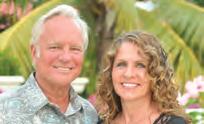


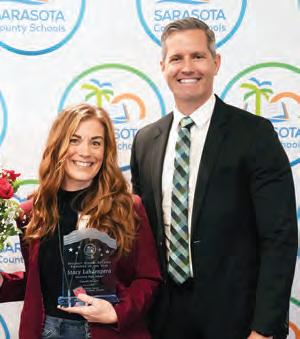
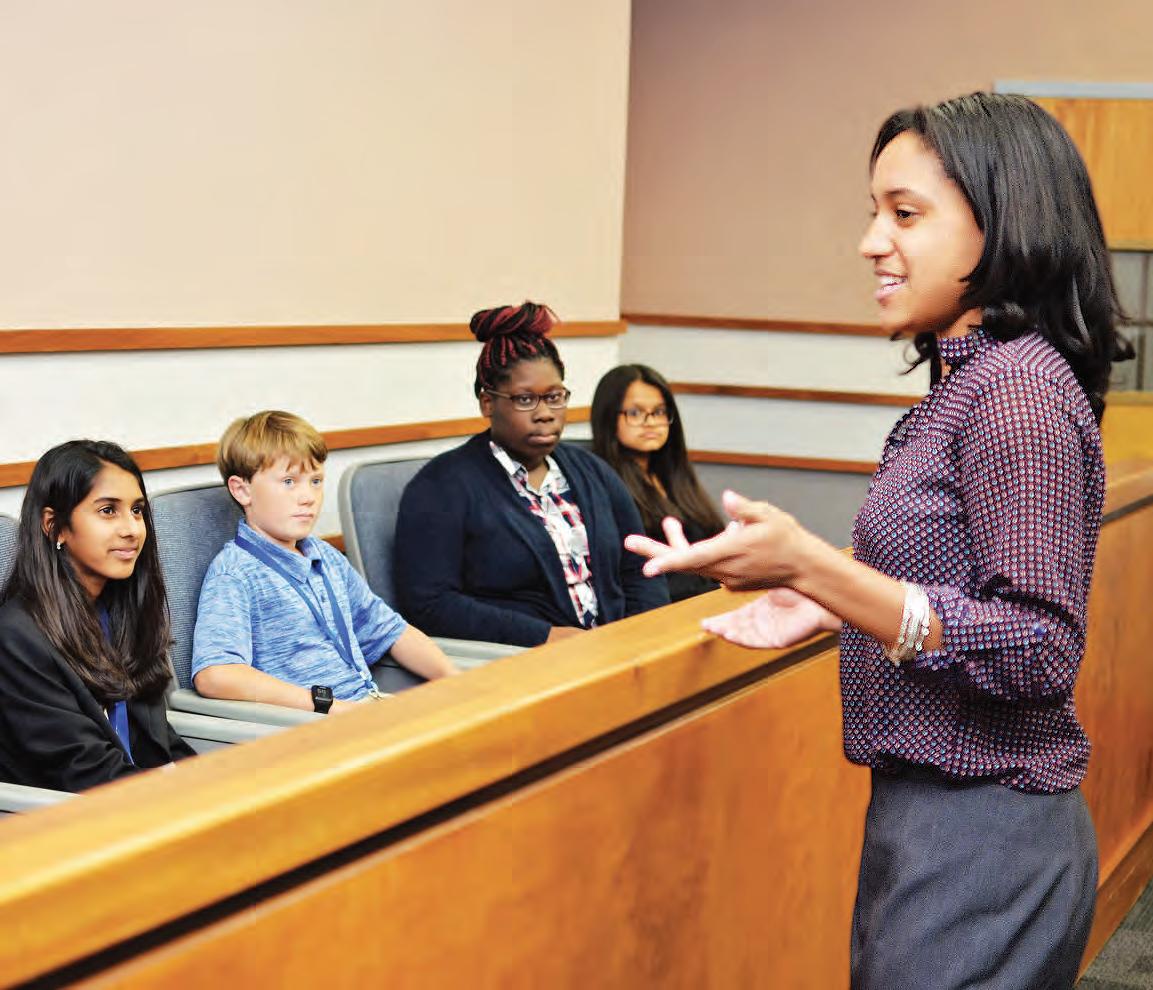

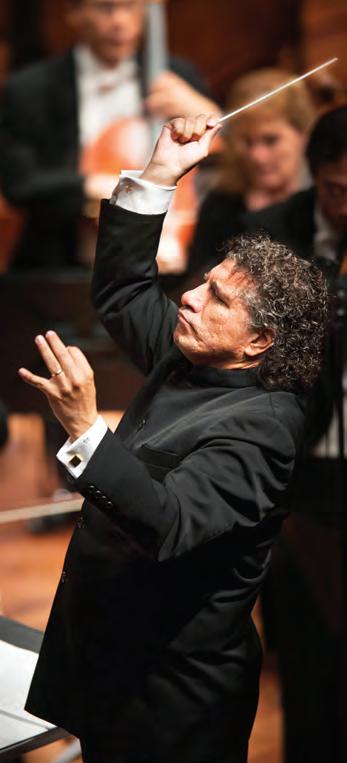








“Decreasing the general public’s access to one of our greatest parks and open spaces, which is the beach, is just absolutely something I cannot support.”
Sarasota Vice Mayor Jen Ahearn-Koch. Read more on Page 5A
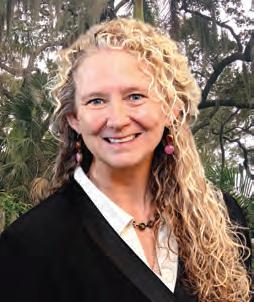

Newsweek has named Sarasota Memorial Hospital as among the world’s best in its sixth annual global hospital ranking.
For 2024, Newsweek and global data firm Statista ranked more than 2,400 hospitals across 30 countries. SMH-Sarasota was one of 412 hospitals in the United States and 18 in Florida to make the list, which is based on patient care quality metrics and surveys of patients, physicians and hospital staff.
SMH-Sarasota has earned a
spot on the list every year since the global rankings began in 2019. For 2024, it was ranked No. 131 among U.S. hospitals.
“The people who work here are what sets Sarasota Memorial apart,” said Sarasota Memorial Health Care System CEO David Verinder in a news release. “There is a sense of pride and community ownership that has been passed down through the decades.”
According to Newsweek, the goal of the study is to provide a data-based comparison of
hospital reputation and performance. In addition to quality of care, research and innovation, the publication notes consistency as among the most important qualities of top hospitals.
The ranking lists the best hospitals in 30 countries based on comparability factors, such as standard of living and life expectancy, population, number of hospitals and data availability.
The full list is published at Newsweek.com/Rankings/ Worlds-Best-Hospitals-2024.
The FDOT will hold a hearing for the Little Ringling Bridge Project Development and Environment Study Thursday, March 21, at St. Armands
Key Lutheran Church, 40 N. Adams Drive. The project area is between Bird Key Drive and Sarasota Harbour West.
The in-person open house will begin at 5 p.m. The virtual and in-person hearing and testimony portion will begin at 6 p.m.
Alternatives are being evaluated to address structural integrity because of the age and operational deficiencies of the existing bridges.
To view the hearing online, advance registration is required at Bit. ly/LittleRinglingPublicHearing. From 5-6 p.m., in-person attendees can view project materials and speak with the team. The virtual and inperson hearing and testimony will begin at 6 p.m.
All meeting materials, including the presentation, will be available online at SWFLRoads.com/Project/436680-1 by March 14. Comments can be provided through the project website. Project documents will also be available for public viewing through April 4 at Selby Public Library, 1331 First St. in Sarasota and at FDOT District One Manatee Operations Center, 14000 East S.R. 64 in Bradenton.
Tax collector files for 10th-straight term
Barbara Ford-Coates has filed to run for her 10th term as Sarasota County Tax Collector. She was first elected tax collector in 1984 and has held the office since.
The Tax Collector’s Office collects property, business and tourism taxes; issues drivers’ licenses, vehicle registrations, hunting and fishing licenses; and performs other state and local services. The office has a staff of 100 and an annual budget of more than $10 million.
Ford-Coates is being challenged by Sarasota County Commission Chairman and District 1 representative Mike Moran, whose second four-year term expires this year. County commissioners are limited to two terms.


Sarasota-Bradenton International Airport is positioned for major growth. Here’s the math on what makes it go.
ANDREW WARFIELD STAFF WRITERThinking back to 2017, SarasotaBradenton International Airport President and CEO Rick Piccolo recalls running a nice, fairly busy airport shuttling passengers among Sarasota and seasonal residents’ destinations in the Northeast and Midwest, plus a few main hubs.
He could never have imagined, he said, that a half-decade later he would be overseeing the rapid expansion of one of the fastest-growing airports in the world.
The secret of Sarasota, though, was revealed during COVID-19 as the lockdown-weary sought solace, sun and warmth not only in an open state, but in an area that enjoys some of the most highly regarded beaches in the world.
It hasn’t stopped since, and as SRQ’s passenger count grew from 1.18 million in 2017 to 4.32 million in 2023 — through the same 13 gates at an airport designed for 3 million passengers — Piccolo and the Sarasota-Manatee Airport Authority have been planning and executing for growth to perhaps as many as 7 million passengers per year.
Scheduled for completion by the end of the year is the first phase of Concourse A followed by a connecting bridge between concourses A and B, bringing an additional nine gates on the way to an eventual full buildout plan of 32 gates over three concourses.
The gates will be necessary, Piccolo said, because there is no end in sight to the passenger growth.
“Look at how tourism has grown here. That’s not going down. New home construction continues to grow at an exponential rate and people have discovered the area,” Piccolo said. “Another factor is congestion
23,009 jobs: The sum of fulltime and part-time employees plus the number of people employed as a result of the airport.
$1 billion payroll: Total compensation for work, including gross wages, salaries, employer-provided benefits and taxes paid to governments on
expanded baggage handling system, more parking spaces — SRQ is planning development of some 100 acres it owns south of the airfield for rental car service and storage and revenuegenerating commercial space along University Parkway.
Receiving no tax dollars, SRQ is self-sustaining, relying on revenue from leases of airport hangars and commercial buildings, terminal space leased to vendors, parking, landing fees, ticket surcharges, rental car surcharges and more.
And business is good. In 2017, the airport’s net operating revenue was $3.4 million after expenses. Last year, the airport netted $11.7 million and projects to end 2025 at $12.3 million, and that’s before Allegiant begins service out of the five ground-based gates in the new Concourse A.
But the question remains: How did SRQ triple passenger count over six years without adding gates? The answer lies in efficient gate use management and technology.
on roadways. There are other airports in our catchment area that used to be very easy to go to, but now with all the traffic it’s a lot harder, and you have to leave hours earlier than you would otherwise need to because if something happens it could end up taking three or four hours and you still miss your flight.”
In addition to passenger service and capital improvements — including more escalators, expansion of vendor space, an improved and
“The reason we can handle so many is what I call the three-legged stool,” said Piccolo. “No. 1, our airline agreements provide that airlines that are signatory carriers have preferential use of gates they lease, but it’s not exclusive use. When they’re not on the ground, if we have another airline that needs one, we can put them at that gate.
“Second is the common use computer system so that any airline can go to that gate, punch in their ID and then get into their system. The third leg is we have a software system to do gate scheduling.” C
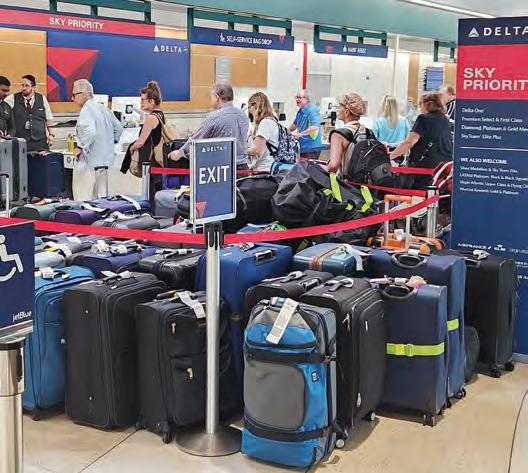
n Ground boarding facility: $104M
n General aviation customs Facility: $8M
n Baggage claim expansion: $12M
n Rental Car Storage Phase 1: $1.5M
n Relocating FAA antennas for cell lot expansion: $3M
n Environmental Assessment (for new concourse extension connecting A to B): $400K
n Vehicle storage building modifications: $2M
n Air cargo building modifications: $1.5M
n Property 9 Development (industrial development of SMAAowned property): $13M
n Consolidated Receiving and
n


FROM THE PLUMBING PLACE

It’s a frustrating reality for many Gulf Coast homeowners –

We eventually learn that the tease of “lifetime brass” really means a lifetime of maintenance and repair. There is a practical solution to this common problem – Bronze or Stainless

Both materials offer excellent salt tolerance and oxidation/corrosion resistance with a minimum of maintenance. A variety of styles and finishes provide a perfect match to existing color schemes including rich patinas of classic bronze, contemporary polished or matte nickel, and black.


Smitty’s Architectural Hardware, located The Plumbing Place, displays many lines of door hardware in beautiful styles for your home that are well suited for our demanding environment, and will create the first impression your front door deserves.

Showroom
OWNER


Beautifully crafted bathroom and kitchen fixtures, fittings and accessories from leading designers. Masterpieces of functionality and style showcased in an astounding showroom.
Visit our showroom or call to arrange an appointment.
5678 Fruitville Road • Sarasota • Florida 34232 • 941.378.5678

Activist Ron Kashden challenges Mayor Liz Alpert in the Sarasota City Commission election.
ANDREW WARFIELD STAFF WRITERSarasota Mayor Liz Alpert has one challenger thus far for the Sarasota City Commission District 2 seat in Laurel Park resident Ron Kashden.
Alpert was first elected in 2015 and is serving her second term as mayor. The Sarasota mayor and vice mayor are selected annually by a vote of the City Commission. Kashden frequently appears before the commission to speak on topics, often opposed to the majority of the board.
Both have filed for the Nov. 5 election with the Sarasota County Supervisor of Elections Office. This is the first time Kashden has run for elected office.
“I’m running to give the public a seat at the table and bring a voice of reason to civic discussions,” Kashden said in a news release. “Engaged leaders approach problems the way software engineers handle bug reports — identify issues, research the causes, consider possible solutions and then implement fixes.”
According to a news release, as a city commissioner Alpert has sup-
ported the creation of The Bay, renovation of the Bobby Jones Golf Course and Nature Park, and the new playground and splash pad at Bayfront Park. She has supported incentives to create more affordable housing and multimodal transportation options to relieve congestion.
“This election is about moving our city forward with smart solutions for local issues,” Alpert said in the news release.
Professionally, Kashden is a certified public accountant and former CEO of a fund accounting software company in New York. Alpert is a family law attorney and principal of Alpert Law of Sarasota.
Kashden’s wife, Kelly Franklin, has filed a defamation lawsuit against City Commissioner Kyle Battie over his racism allegation against her related to an apparent hoax social media post. Battie made the claim during a Jan. 16 commission meeting. Franklin has denied creating the post and her attorney has claimed Battie was aware the post was false weeks before presenting it in the public forum.
To date, Battie, is the lone candidate to have filed for his District 1 seat, and incumbent Erik Arroyo is being challenged by former Planning Board member Kathy Kelley Ohlrich in District 3. Both Battie and Arroyo are running for a second term.



www.theplumbingplace.com
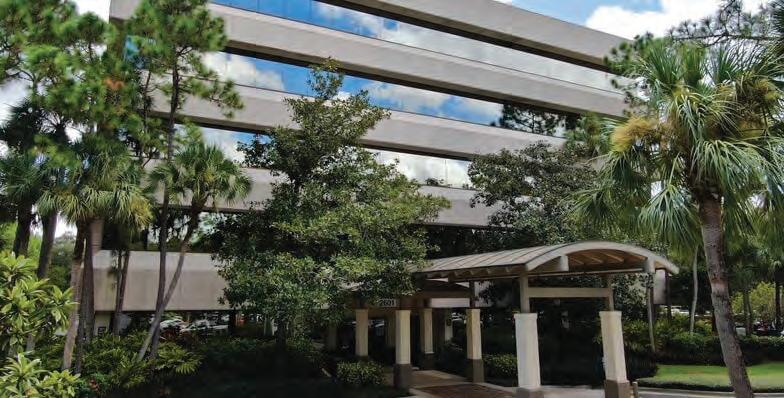

City
Commission approves several initiatives that will result in nearly $1.3 million in additional parking and fine revenues.
Laid out before the Sarasota City Commission on Monday was a “buffet,” as Commissioner Erik Arroyo described it, of items included in a proposed
Manager Broxton Harvey,
Arroyo contended the city was gorging on revenue creation rather than nibbling on ways to improve parking services in downtown, St. Armands and on Lido Key. City Manager Marlon Brown said the parking changes aren’t about making money but rather ensuring the parking division is self-sustaining and that any surplus revenues generated would be allocated toward other transportation costs and improvements. Had all of Harvey’s recommendations been approved by commissioners, it would have resulted in an additional $2.22 million in revenues
in combined fees and fines. With commissioners leaving a few morsels on the serving line, the city has helped itself to approximately $1.29 million in new parking revenue.
“When this was presented to us at our workshop, one of my first questions was, ‘Are you saying that we should adopt all of these, or is this more of a buffet-type of situation?’” Arroyo said after several measures were approved on Monday.
“The answer from staff I recall was no, not all of these. It’s a buffet. And here we are trying to gobble up the entire buffet, so can we please just be a little more reasonable?”
Commissioners didn’t gobble up all of it, leaving $900,000 in revenue on their plates, voting not to adopt a two-hour metered parking enforcement extension and by not increasing fines across the board by $10.
Among the most difficult items to digest was the addition of metered parking at the currently 80 free parking spaces along Benjamin Franklin Drive at Lido Beach, a $1 charge per hour approved by a 3-2 vote. The 368 spaces in the Lido Pavilion parking lot will remain free of charge.
Consistent with their position during a Jan. 8 commission workshop, Vice Mayor Jen Ahearn-Koch and Arroyo were vehemently opposed to charging for beach parking.
“Decreasing the general public’s access to one of our greatest parks and open spaces, which is the beach, is just absolutely something I cannot support,” Ahearn-Koch said.
While both objected to restricting free access to the beach, AhearnKoch was further concerned about overflow parking spilling into nearby neighborhoods while Arroyo took the position that the city shouldn’t increase fees and remove free parking there simply because it can.
When asked, Harvey said he received minimal pushback from the coastal neighborhoods.
“I really haven’t gotten too much negative feedback,” he said of St. Armands and Lido Key neighborhood groups. “I think a lot of people feel that it would actually assist with some of the people parking and ‘camping’ in those spaces, which we get a lot of phone calls regarding that. This would eliminate that issue as well. People actually — quote unquote — spend the night on the beach and park in those spaces.”
The intent of the updated parking plan is two-fold: to ensure the city’s parking program pays for itself and to improve efficiencies.
In addition to Lido Beach parking, commissioners had several more items on their plates. They included:
■ Gateless garage program, which will eliminate gates in city-owned parking structures in order to increase ingress and egress speeds. That was approved 5-0.
■ Waiver program removal, which eliminates parking waivers for firsttime offenders. Waivers were offered as a temporary program, which was
implemented in 2019 when the parking program began. That was approved 4-1 with Arroyo opposed.
■ Extending parking enforcement by two hours until 10 p.m., excluding Sundays and holidays. The intent is to assist with parking turnover of vehicles and increase the available spaces for customers of downtown businesses. Ahearn-Koch motioned to deny the measure, which died without a second. However, that was followed by a motion to approve, which failed 4-1 with Trice in favor, effectively denying approval as Ahearn-Koch motioned.
■ Sunday safety parking enforcement to issue citations for violations such as double parking, blocking drive lanes, blocking fire hydrants, ADA violations, illegal ADA parking, etc. That was approved 4-1 with Arroyo opposed.
■ Initiate Centennial Park boat ramp parking fees at $5 for single vehicles and $10 for vehicles with boat trailers. Currently, parking at the boat ramp is free, although 70% of users are for commercial purposes. A 3-2 vote to not approve was later rescinded by Battie, who said he changed his mind after it was explained to him that a significant number of users of the boat ramps are not city residents. A revote to approve passed 3-2, with AhearnKoch and Arroyo opposed.
■ Initiate a fee of $1 per hour for use of electric vehicle charging stations in city-owned garages. That was approved 4-1 with Arroyo opposed.
■ Limit metered parking spaces to credit card payment only. That was approved 5-0.
■ Increase appeals fee from $7.50 to $25 to cover the cost of the magistrate. Customers who win the appeal do not pay the citation or appeals fee. That was approved 4-1 with Arroyo opposed.
■ Increase parking citation fee schedule by $10 above the current fines of $25, $30 and $35. Fines paid within 24 hours of the violation date and time shall be reduced by $5. A motion to deny approval passed 5-0.
■ Reduce the free parking period in parking garages from two hours to one hour. That was approved 3-2 with Ahearn-Koch and Arroyo opposed.

Affordable housing incentives net first-round approval despite commission disagreement over the percentage of attainable units.

Before
for April 1. Although Vice Mayor Jen AhearnKoch and Commissioner Debbie Trice voted against approval, it was not out of opposition to affordable housing, but rather the percentage of attainable units provided per project. More to the point, the lack of them when compared to the overall density bonuses.
Both Ahearn-Koch and Trice argued that with an average net gain of 11.5% of the units per project reserved for households earning up to 80%, 100% and 120% of the area median income, the additional density of market rate units will only exacerbate the city’s current crisis of not enough workforce housing to keep up with the service needs of the population growth. Each qualifying project must provide one-third of the affordable units at each of those AMI tiers for 30 years.
They also argued that triple the base density as an incentive is too much for the rate of return.
The ordinance provides that, to qualify for density bonuses of up
“I think we could have asked for much more, so I can’t support this. I think we could do much better.”
Vice Mayor Jen Ahearn-Koch
to three times zoning restrictions, 15% of the additional units must be reserved for affordable and attainable housing for at least 30 years.
“I think we could get much, much more affordable housing because Sarasota is such a desirable place to be,” Ahearn-Koch said. “I think we could have asked for much more, so I can’t support this. I think we could do much better.” Much better than 15% of the bonus density, which she contended will only add to the affordable housingto-market rate ratio deficit.
Planning staff countered that the city has in the past attempted to incentivize affordable housing at a higher percentage with a 25% minimum of the bonus density in the Rosemary District, a formula that yielded zero new affordable units over more than a decade. Ahearn-
Koch suggested somewhere between 15% and 25% should be the target range to yield the desired benefit.
“That’s a policy decision from the commission,” said City Manager Marlon Brown. “If you raise that, you’re not going to get any pushback from us. Our only fear is will developers take advantage of it.”
Planning Director Steven Cover said the 15% of bonus density is yielding results in the downtown zoning districts with several projects working their way through the approval process. The proven formula, he said, should be duplicated.
“Keep in mind that we’re at 15% of the bonus units now in downtown, and it’s already working,” Cover said. “If we go to 17% or 20%, we might get zero.”
Planning General Manager Ryan Chapdelain told commissioners the affordable housing overlay along commercial centers and corridors permits mixed-use development where currently only commercial may be built, and that a key part of the goal is to encourage walkable communities where residents may live, work and shop without driving.
Siding with the majority, Commissioner Kyle Battie said that while an affordable unit net yield of 11.5%
of the overall development may not be ideal, it’s good enough and can be adjusted going forward.
“I don’t want to sacrifice good for perfect. Nothing is perfect,” he said. “Prior to this commission there was no affordable housing. Without this, we yield it zero.”
In support of the ordinance, Mayor Liz Alpert said the bonus height and density are necessary to offset the cost of building and holding the affordable units for a minimum of three decades.
“You need 200 or 300 units and five stories because of the cost related to doing apartments and condos with affordable housing,” Alpert said. “You have to have the density to make it work, and this density is also helping with increasing the supply, which also creates more affordable housing. The place to do it is in the downtown and along busy corridors and our commercial areas.”
Among the Planning Board provisions for recommendation for approval is a to make neighborhood workshops for applicable developments a requirement, rather than voluntary as was originally proposed.






■
■
■
■

State dismisses charge that a sexual encounter was recorded without consent.
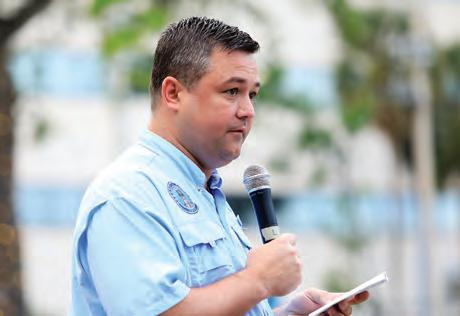
feet from the woman, who was on the bed when the recording ended.
“The video did not appear to be taken from any hidden device or secretive angle that would tend to show that a phone recording a video was being hidden from the victim,” the report reads.
The woman’s unsubstantiated claim of sexual assault came following what was first planned as a threesome between the woman, Ziegler and Ziegler’s wife, Bridget.
When only Christian Ziegler arrived, the woman said she called off the encounter, but Christian Ziegler forced his way into her apartment and sexually assaulted her.
were not pursued.
In its conclusion, the office wrote, “The victim’s expressed inability to recall whether she consented to recording the sexual activity along with her inconsistencies pertaining to key details of the event leave the State unable to demonstrate beyond a reasonable doubt that the video in question was filmed without her knowledge or consent. Accordingly, no charges will be filed.”
The video itself, the report reads, does not capture any explicit statements indicating the woman knew of, and consented to, the recording. It does show the phone was visible either in Ziegler’s hand or on the bed where the encounter occurred. Ziegler picked up the phone to end the recording while standing a few
Security camera footage in the apartment hallway did not back up her claim, nor did the video of the encounter itself. In the meantime, the former Sarasota County Commissioner lost his position with the state GOP and Bridget Ziegler has faced pressure to resign from the Sarasota County School Board.
The report reads that law enforcement has been unable to recover “vanish mode” Instagram messages between the two, and even if they were recoverable within 30 days, they are wiped from servers after.
“That would mean this potential evidence was already gone around the time of the defendant’s first interview on Nov. 2, 2023,” the report reads. “In another interview on Dec. 1, 2023, the defendant added that he asked the victim before hitting record and she said yes to the recording.”










New College of Florida’s new president, Richard Corcoran, and the DeSantis board appointees have an ambitious plan. But when you analyze the economics, you can’t justify the $400 million-plus cost to taxpayers.

Everyone who has followed the life and times of New College of Florida probably remembers the legislative session of 2020.
That is when Rep. Randy Fine, R-Palm Bay, one of the Republican fiscal hawks and then a close ally of Gov. Ron DeSantis, surprised his legislative colleagues and everyone in Sarasota with a bill proposing to merge New College of Florida with Florida State University.
Fine, known for being direct, unapologetic and uncompromising, railed that New College and its sibling, Florida Polytechnic University in Lakeland, were costing taxpayers far too much money for what they were delivering and producing.
Many wondered: Where did this come from? The governor? Surely, Fine would not have made such a bold move without the governor’s blessing.
“We have an obligation to taxpayers to generate degrees at the lowest possible cost,” Fine told a Florida Politics reporter. “These two colleges cost an extra zero versus the other 10 in the system,” he told the Tallahassee Democrat.
“The problem with Florida Polytechnic and New College,” he said, “is they are so small, there are not a lot of students to spread these expenses around.”
You may remember: Fine’s bill died. The public outcry from Sarasota, Manatee and Polk counties snuffed it.
But the post-mortem talk among Sarasota and Manatee legislators was that New College needed to do something to turn things around. It now had a target on its back.
“Something is going to happen there,” Sen. Joe Gruters told us then.
Alas, something indeed. Something totally opposite and incongruous with rational, fiscally minded politicians.
In the past four sessions since, Fine hasn’t touched the issue — even though he was (and is) right: Economically and fiscally, there is no justification to taxpayers to keep New College alive.
But lo and behold, two of Florida’s allegedly leading fiscally conservative politicians — Gov. DeSantis and former House Speaker and Florida Education Secretary Richard Corcoran — somehow believe it is worthwhile for Florida taxpayers over the next five years to pump $227 million in tax dollars and $189 million more borrowed through bond issues — $416 million altogether — essentially to create a new New College campus, complete with new dormitories, a Freedom Institute and athletic teams and fields of which even IMG Academy would be envious.
All this to fulfill Corcoran’s vision — or should we say: starry-eyed dream — of turning around what has always been a financially struggling, often gasping, liberal arts honors college into “the best liberal arts college in America.”
The question Gov. DeSantis and Florida lawmakers should answer and make the case is: Given New College’s 64-year history of financial teetering, should Corcoran’s noble quest, and frankly monumental turnaround, be executed and gambled with Florida taxpayers’ money?
Indeed, if you were asked to invest in this venture, with the expectation of a decent return on

the investment, in all likelihood, you would say an unequivocal “no.”
The New College business plan is convincing. (See YourObserver. com/Opinion/NCF.)
EINSTEIN, JOBS, ARCHIMEDES
We’re always told: Chase your dreams. Dream big. Shoot for the stars. Pursue your passion.
For all that, you can admire Richard Corcoran’s vision for New College. After a 30-year career in Tallahassee, he is pursuing a passion — the liberal arts.
If ever there was a champion of the liberal arts, Corcoran is a walking curriculum. He flexed that knowledge in the 104-page business plan. It’s probably the only business plan in America that quotes George Washington, Albert Einstein, Steve Jobs and the ancient Greeks.
“With this plan,” the business plan states, “we rely on a famous saying of the Greek mathematician Archimedes: ‘Give me a place to stand, and I will move the Earth.’ Give New College firm ground, and we will deliver on the promise of 1960.”
It’s probably the only business plan for a college that uses 700 words to explain in detail the failure of the Japanese education system for producing students who are more robots than independent thinkers.
According to Corcoran’s plan, “We will create an academic program that unites technological learning with the liberal arts so that we may achieve great success without sacrificing our idealism or, as befell Japan, a prosperous reality.”
The prose in the plan gets even
deeper. Check out the accompanying box below.
All that liberal arts idealism sounds impressive. But you feel like you’re reading a student’s dissertation from the 1970s book and TV series, “Paper Chase,” starring the erudite Harvard law professor, the late actor John Houseman.
In typical business plans, potential investors don’t want to read 11 pages of narrative that includes an explanation of “the Ancient Greek concepts of Logos and Techne.” They want to know: How are you going to make money, stay in business and grow?
As with optimistic entrepreneurs, Corcoran has a proforma for New College enrollment that predicts it will grow from 700 to 1,200 in five years. By comparison, it took Larry Thompson and the Ringling College of Art and Design eight years, from Thompson’s start in 1999 until 2007, to go from 700 students to cross the 1,000-student threshold.
To boost enrollment, the business plan spells out three strategies — all of which will require millions of dollars:
■ Updating and developing a new physical campus.
The New College campus is far from a recruiting attraction. In fact, as you read Corcoran’s business plan, you can see a costly challenge to the turnaround. The campus has a $61 million maintenance backlog. The business plan lists 42 specific projects to be addressed, everything from “long overdue mold assessment” to refurbishing the Cook Hall kitchen to be able “to recruit top
professionals” to resurfacing “pothole riddled” General Twining Road and more. “New College has already invested more than $500,000 per year in the quality of food being served, improving from ‘D’ rated food to ‘A’ rated,” according to the business plan.
■ Creating from scratch an athletic program. Corcoran is counting on the addition of sports as a key to enrollment growth. In this year’s budget, the school is spending $2,134,499 for the startup men’s soccer, baseball and basketball and women’s soccer, softball and basketball. In the fall, the school expects to add lacrosse, golf and volleyball. So far, New College has enrolled 152 student-athletes and hired 10 coaches. (See YourObserver. com/Opinion/NCF.) The athletic director’s salary and benefits are $290,299; the men’s soccer coach is at $108,040; and the women’s lacrosse coach is at $94,058.
The business plan makes no mention of how these sports programs will generate pay for themselves.
■ Enhancing curriculum and attracting top-flight professors. In higher-education circles, one of the accepted maxims for success is this: Curriculum drives enrollment.
To that end, New College is introducing three new master’s degree programs: the nation’s first master’s in marine mammal science, along with establishing a New College Institute of Marine Mammal Science; a master’s in environmental economics and policy; and the third, a master’s in Educational
An excerpt from the “Economic Argument” in the New College business plan:
“The liberal arts curriculum that New College is developing will require students to confront enduring human questions of virtue and justice, and to explore them through the careful study of the Great Works.
“By ‘Great Works,’ we mean those exceptional and enduring texts whose richness and complexity provoke ever renewed questions about what it means to be human. What makes life
worth living? What makes it extraordinary? What do we owe to each other? To ourselves? What should be preserved, and what altered?
“Are there right and wrong, better and worse ways to pursue and answer these questions, and to live the lives that these answers promise? …
“New College’s curriculum will invite students to plumb the depths of complex and enduring masterpieces, to wrestle with their truths as they are challenged to think harder about beauty, knowledge, virtue,
“If we are to build a better world, we must remember that the guiding principle is this — a policy of freedom for the individual is the only truly progressive policy.” Friedrich Hayek “Road to Serfdom,” 1944
President and Publisher / Emily Walsh, EWalsh@YourObserver.com
Executive Editor and COO / Kat Wingert, KWingert@YourObserver.com
Managing Editor / James Peter, JPeter@YourObserver.com
Sports Editor / Ryan Kohn, RKohn@YourObserver.com
Staff Writers / Ian Swaby, ISwaby@ YourObserver.com; Andrew Warfield, AWarfield@YourObserver.com
Digital & Engagement Editor / Kaelyn Adix, KAdix@YourObserver.com
Copy Editor / Gina Reynolds Haskins, GRHaskins@YourObserver.com
Senior Editorial Designer / Melissa Leduc, MLeduc@YourObserver.com
Editorial Designer / Luke Reasoner, LReasoner@YourObserver.com
A+E Editor / Monica Roman Gagnier, MGagnier@YourObserver.com
Director of Advertising / Jill Raleigh, JRaleigh@YourObserver.com
Regional Sales Director / Penny Nowicki, PNowicki@YourObserver.com
Regional Digital Director / Kathleen O’Hara, KOHara@YourObserver.com
Senior Advertising Executive / Laura Ritter, LRitter@YourObserver.com
Advertising Executives / Richeal McGuinness, RMcGuinness@ YourObserver.com; Lexi Huelsman, Lexi@ YourObserver.com; Jennifer Kane, JKane@ YourObserver.com; Honesty Mantkowski, HMantkowski@YourObserver.com; Toni Perren, TPerren@YourObserver.com; Brenda White, BWhite@YourObserver.com
Classified Advertising Sales Executive / Anna Reich, AReich@YourObserver.com
Sales Operations Manager / Susan Leedom, SLeedom@YourObserver.com
Sales Coordinator / Account Manager Lori Downey, LDowney@YourObserver.com
Advertising/Marketing Coordinator / Caitlin Ellis, CEllis@YourObserver.com
Digital Fulfillment Specialist / Emma B. Jolly, EJolly@YourObserver.com
Director of Marketing / Robin Lankton, RLankton@YourObserver.com
Marketing Specialist / Melanie Melone, MMelone@YourObserver.com
Director of Creative Services / Caleb Stanton, CStanton@YourObserver.com
Creative Services Administrator / Marjorie Holloway, MHolloway@ YourObserver.com
Advertising Graphic Designers / Luis Trujillo, Taylor Poe, Louise Martin, Shawna Polana
Digital Developer / Jason Camillo, JCamillo@YourObserver.com
Information Technology Manager / Homer Gallego, HGallego@YourObserver. com
Chief Financial Officer / Laura Strickland, LStrickland@YourObserver.com
Controller / Rafael Labrin, RLabrin@ YourObserver.com
Office and Accounting Coordinator / Donna Condon, DCondon @YourObserver.com
creativity, justice, faith, relationships and all that it means to be human.
“We expect New College students to succeed in the marketplace and to contribute to the development of the Florida economy. But successful education cannot be reduced solely to dollars or metrics.
“We seek to produce graduates who have thought deeply about the big questions and as a result are exemplary parents, citizens, neighbors and leaders.”
YourObserver.com
Reserved

Leadership.
What appears to be a linchpin to the New College turnaround is the creation of the Freedom Institute. The business plan says the college will require its first-year students to go through an orientation “which addresses the importance of free speech and inquiry … The New College Freedom Institute will promote tolerance of opposing views and a willingness to engage such views in civil discourse.”
The business plan shows construction of the Freedom Institute projected to cost $49,108,054 — a request to the Legislature over three years.
Add to that salaries and benefits for the 2023-2024 budget year. They are scheduled to increase 23% from the previous year, from $31.7 million to $39 million.
With costs approaching a halfbillion dollars, it’s an understatement to say Corcoran and the New College board are embarking on a huge undertaking just to renovate and develop a small college campus. Add to that transforming at the same time the school’s entrenched curriculum, faculty and — this is the big one — culture.
Business people who have been through mergers and changes in ownership know that more often than not such transitions are fraught with pain, agony and disruption. When new bosses come in, typically there are waves of exoduses of longtime managers and staff members whose ways of operating are not in alignment with the new regime.
Corcoran has been going through that ever since his appointment as interim president in January 2023. In effect, when DeSantis inserted Corcoran into his position and loaded the New College board with strident voices in American conservative circles, even though they vowed to build on New College’s tradition as Florida’s liberal arts honors college, their message to the faculty, staff and students essentially was negative: “We’re throwing out most of what you do and starting over.”
For at least a year in any change in leadership and ownership, you can expect the turnover to be consuming and disruptive, if not destructive, to any cohesive culture.
That puts the new leadership in the throes of recruiting and bringing in a new team from the outside

Increasing enrollment can bring New College’s ratios more in line with the other state universities. But here is the conundrum: If New College is to be the best liberal arts honors college in the U.S. and Florida, with a peak enrollment reaching 2,000, its cost-per-student will always be high.
As the Legislature completes its 2024 session, it once again is appropriating record levels of taxpayer dollars to New College.
In the 2023 legislative session, lawmakers appropriated a record $66.5 million in general revenue and lottery funds, more than a 30% increase from the previous year. In the session about to be completed, the appropriations bill allocates $82,334,334, a 24% increase over 2023-24 appropriations.
For $15 million of the $82.3 million, New College is required to submit a detailed business plan and quarterly reports to the chairs of the Senate and House appropriations committee — clearly a measure to hold Corcoran and the New College Board of Governors accountable.
But in the real world of private enterprise, investors would have asked tough questions before writing investment checks for $82.3 million.
Among those questions: What are the alternatives? If the state is to invest $500 million over five years, is there a better, more productive use for that capital?
We often tell the story of a board member of a large retail chain. After he listened to the CEO tell the board how the company was going to invest millions of dollars to improve its money-losing stores, the board member commented:
■
■
■
■
■
■
Non-operating revenues
■
■
■
■
— often people with whom they haven’t worked and don’t know if they will fit. It’s the process that Jim Collins of “Good to Great”
fame coined: Getting the right people in the right seats on the bus. It’s hard, long and costly. Making this more difficult is the perception that filters out in the marketplace. While there likely are many professors and students who would prefer working and living on a campus of like-minded conservatives, it doesn’t help that when someone does a Google search for New College, not surprisingly, the preponderance of articles leans toward those attacking the New College board and Corcoran’s generous compensation ($699,000 annual salary, plus
$200,000 in available incentive bonuses).
If Corcoran and New College were a private enterprise trying to raise capital in the public market, you can be sure many savvy investors would conclude: Why get involved? There are better, safer, less controversial bets.
Investors would make that conclusion just looking at the college’s financial history.
In spite of its academic achievements — “roughly one-third of all (New College) science graduates since 1967 have earned an M.D. or Ph.D.” and the most Fulbright scholars among Florida universities), operating losses are a New College tradition.
In 1975, 15 years after its founding, New College avoided bankruptcy by becoming part of the University of South FloridaSarasota-Manatee. The marriage was a rocky clash of cultures that didn’t work.
In 2001, then-Senate President John McKay of Bradenton persuaded Gov. Jeb Bush and legislators to save New College again, giving it status as the state’s 11th independent public college. That also gave it access to state funding
— and kept it alive. But still today, New College’s finances fall on the bottom rungs of the state university system.
Mind you, none of Florida’s 12 universities would be in existence were it not for taxpayers’ funding. Tuition payments and fees don’t come close to covering the dayto-day operating costs. To operate at breakeven or achieve a surplus, the universities count on a myriad of sources of revenues (see box).
But even then, over the past five fiscal years, in a sampling of seven of the universities, here’s a ranking of how many years they reported deficits:
University of Florida — 1
Florida State, Florida Atlantic, Florida Gulf Coast — 2 Florida Polytech — 3
University of South Florida, New College — 5
Perhaps more telling for taxpayers is how little student tuition and fees cover a university’s expenses and how much the schools rely on state funding.
For New College, tuition and fees have covered only 5.6% to 11% of day-to-day operating expenses. In contrast, at the University of Florida, Florida State, University of South Florida, University of Central Florida and Florida Gulf Coast University, tuition and fees cover from 30% to as high as 48% of operating costs.
State funding typically has made up 90% to 94% of New College’s annual operating revenues, while it accounts for 51% to 70% of the operating revenues for those other five universities.
“Why not invest that money in our better and best performing stores to make them even better?”
We also asked a veteran of corporate boards to review the New College business plan with the thought of whether he would invest in President Corcoran’s plan to transform New College.
His response:
“To be the best liberal arts college in America: How will this be measured? It doesn’t say.
“Further, there was no timeline; nor a cash burn rate on the sports program.
“When I look at a business in which to invest, here is what I look for:
“
■ What is the product?
“
■ Why is the business’ product better than what is currently available?
“
■ What is the size of the market, and what share does it believe it can capture?
“
■ What investment is required to bring the product to market and capture that market share?
“
■ How long will it take to bring the product to market?
“
■ What is the expected return on the investment?
“Always the same six questions.
“I could not find the answers to any of these questions.”
Over its history and in spite of its challenges, New College of Florida triggers emotional community pride in Sarasota and Manatee counties, and rightfully so.
But for Florida taxpayers, the governor and Corcoran’s ambitions and dream to transform New College raise legitimate questions about their and the Legislature’s stewardship of taxpayer dollars.
Even though New College is just a tiny blip in the overall amount of money taxpayers contribute each year to Florida’s 12 universities — 1.6% of $5.13 billion, just imagine if any of you — with no experience in running a college or university — went to the governor and Legislature and asked them for $500 million to build “the best liberal arts college in America.”
Ha! They would send you packing. Rep. Randy Fine was correct in 2020. New College should have been merged into one of the bigger universities or been sold. But here we are.
We wish DeSantis and Corcoran luck. But as many investors who put capital into startups and turnarounds know, more often than not, they require twice as much money and twice as much time — and no guarantee of success.
Whether as an intimate comedy venue or home for extreme sports, myriad options exist for repurposing, say consultants to Purple Ribbon Committee.
ANDREW WARFIELD STAFF WRITER
For the first time since it began meeting in August 2023, Sarasota’s Purple Ribbon Committee heard a presentation directed at its core mission to research and eventually recommend alternative uses for the Van Wezel Performing Arts Hall.
Committee members heard from Lynn Singleton, president and CEO of Professional Facilities Management Inc., which has management, booking and consulting contracts with nine facilities in five states, including Florida. He is also the owner’s representative, in this case the city of Sarasota, with respect to the Purple Ribbon Committee’s work.
Singleton has a stake in the community as well. A dual resident, he has homes in Providence, Rhode Island, where the company is headquartered, and in Manasota Key. Among the facilities the company manages is the Barbara B. Mann Performing Arts Hall in Fort Myers. Alongside Mary Bensel, a city staff member and executive director of the Van Wezel, Singleton presented a list of options for repurposing the facility with a prime directive to complement — not compete with — the planned Sarasota Performing Arts Center should it be built just a few hundred yards away.
To accomplish that objective, Singleton encouraged committee members to imagine “a facility that creates flexibility and evolves with emerging trends so it’s not static. If something comes along new, then you can adapt to that rather than
start over again.”
To get that conversation started, Singleton and Bensel proposed options ranging from a niche performance venue to an extreme sports facility.
“The concept would be to rightsize the seating and the ancillary space,” Singleton said. “If you went down to 1,000 or 1,200 seats you wouldn’t be jammed up with in the aisles, concessions, bar areas, etc,” Singleton said. Less seating will attract a greater number of smaller shows, such as comedians and, as Bensel pointed out later in the discussion, immersive theater that surrounds and involves the audience.
“What is really working in our industry right now, what I call the sweet spot, is comedy,” Singleton said. “People want to laugh. There’s a chain of how the comedians work. They don’t automatically play the big room. They start in a comedy club, then they go to a medium-sized facility and play to about 1,000 seats, and then they go to the big room.”
Another concept they introduced is flat flooring, which can accommodate performances as well as event space, the latter of which is in short supply here. Such a floor, Bensel said, can actually be flipped to provide flexibility in uses.
“It’s a floor that literally flips so you can have it seated or being like a flat floor venue,” said Bensel.
But that comes with a flip side, as it were. Bensel said she asked a friend who operates such a venue how many times the floor breaks down. “He said not that many, so that was my concern.” She added, though, that she was told the floor is flipped often.

Singleton was not an advocate of the floor-flipping concept.
“Candidly, I would not do it. It’s very expensive, and you’re supposed to be able to push a button and it happens. Well, nothing is ever that simple,” he said. “What I would do if I had a flat floor is I’d have chairs and maybe do some pretty cool risers, but flipping can be beyond expensive, and you’d probably spend more time making it work than you’d ever imagine.”
As a performance venue, the
PRC was urged to consider:
■ Right-size seating and ancillary space
■ Flat/flexible flooring and staging
■ Niche or diverse programming
■ A feeder venue to and from the new Sarasota Performing Arts Center
■ Options to capitalize on the bayfront
As an extreme sports venue: Indoor sports:
■ Rock climbing and bouldering
Skateboarding and BMX
■ Axe throwing
■ High ropes
■ Escape rooms



Outdoor sports incorporating the waterfront:
■ Waterskiing
■ Kite surfing
■ Parasailing
■ Jet skiing
■ Kayaking “The third idea is niche destination,” Singleton said. “It plays into the relationship that this community has with the circus and Ringling Brothers, and looking forward to that is you establish a venue so that several times a year you go in with them and promote through them, and there are other cirque organizations besides Cirque du Soleil. There’s actually an excellent one in Broward County.”
The building could also serve as a meeting, function and exhibition venue for:
■ Galas, proms and receptions
■ Indoor festivals, trade shows, etc.
■ Function and performance venue supported by flexible spaces
■ Outreach and education opportunities
Shifting demographics should be a consideration when imagining the repurposing of the Van Wezel,



presenting an opportunity to serve a wider swath of the region’s population. Committee member Selma Goker Wilson asked Bensel about trends in audience demographics that may help guide future discussions.
“We have some data that was done from 2010 to 2022, and 65-plus has grown,” said Bensel. “What decreased a little bit, by 2.3%, was the (ages) 35 to 49, but in the 20 to 34 age, it increased by 25.6%.”
Singleton also raised the prospect of converting the building into an outdoor shell perhaps, should the engineering work, preserving the iconic roof of the Van Wezel.
“If you did an outdoor shell, whether the one is there adaptable or not, it’s a lost opportunity to do outdoors in Florida on a bay that’s a $10 million view,” Singleton said. “We always think about in-season here, but October and November are lovely, too.”









Following hours of public comment, school board approves the application of Sarasota Classical Preparatory Academy.
JAMES PETER MANAGING EDITORIt’s practically a foregone conclusion, said Bridget Ziegler, Sarasota County School Board member, in her pre-vote comments.
But speakers during the three-hour public comment portion of the March 5 school board meeting didn’t feel the same way about the charter school application from Sarasota Classical Preparatory Academy.
The school board ultimately approved it by 4-1 vote with board member Tom Edwards the lone dissenting vote, but not without repeated criticism from the public of the applicant, its application and corporate charter schools in general.
The applicant, Florida Charter Education Foundation Inc., intends to contract with service provider Charter Schools USA, a for-profit education management company that operates over 100 schools in five states serving more than 75,000 students, according to its website.
Sarasota Classical Preparatory Academy’s application projects it will serve 1,235 students in grades K-12 by its fifth year of operations.
Before the board voted, Edwards said that he had not received one email or heard one comment in support of the school’s application. Further, he said the applicant had stacked the deck against the board.
Edwards was referring to the application being submitted on Dec. 13, 2023, which he characterized as being done to “exploit” the holiday break taking place during the review period.
Under state statute, a school board that receives a charter school application must approve or deny it within 90 days of receipt.
“There’s still confusion in my mind as to what exactly their interpretation of what classical education is,”
said Edwards. “There’s still confusion and high drama surrounding their proposed location. There’s no food or transportation plan. There’s a $350,000 custodial budget line — that’s going to be the cleanest school on the planet.”
“A location for SCPA has been identified at 8751 Fruitville Road in Sarasota, Florida. Should the site become unsuitable, a new location will be identified,” states the application.
The Classical Academy of Sarasota, a private school, currently occupies the site but has plans to relocate, according to the application.
The requirements of the statute were met, Superintendent Terry Connor explained.
“We noticed that there are concerns, but we do believe after legal has reviewed, our charter committee has done its capacity interview, that it does meet the requirements of the checklist that is provided by the state. … It meets those requirements in order to be approved.”
And in response to a question from Board Chair Karen Rose about the legal defensibility of a no vote on the school’s application, Patrick Duggan, board attorney, replied, “This is a matter of statute, and it’s something that the Legislature has addressed. In Tallahassee, by mandate, they have taken away — largely — this board’s discretion when it comes to the approval, or really the denial, of a charter school.”
The Florida Department of Education has 22 criteria when evaluating a charter school application, explained Duggan. If those are met by an application, then it can be denied by a school board only for good cause, which the board would be required to support with findings related to the FDOE standards.
A denial would have likely led to an appeal from the applicant, which would have then been reviewed by the State Board of Education whose decision is final, subject to judicial review, according to the FDOE.
If the matter went to court, the winning party would be “entitled” to recoup legal fees from the losing side, said Duggan. “All the way to this point (today).”



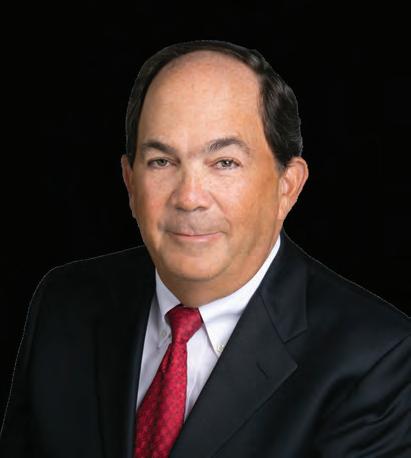








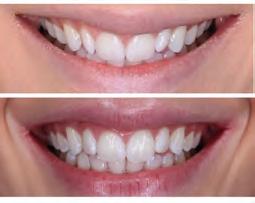






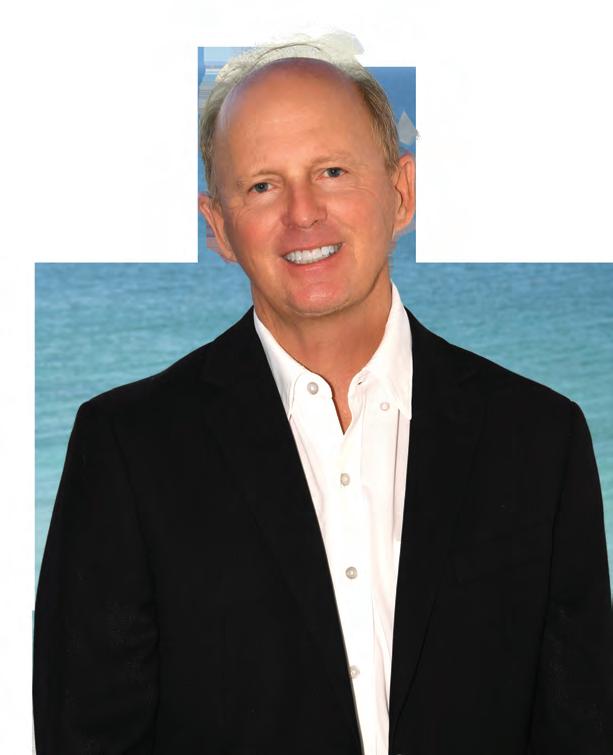



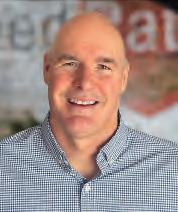













Suspected bank robber brandished a gun before shots rang out as the sequence of events was not clearly shown.
Although the Florida Department of Law Enforcement investigation remains underway in a police shooting of a bank robbery suspect that occurred the morning of Feb. 26, the Sarasota Police Department on March 1 released footage of the incident from body cameras worn by five officers.
None of the videos clearly show the shooting, but what the footage did demonstrate is that while officers were in pursuit of 54-year-old William Michael Pickett, in attempting to elude arrest, he backed his car into a pond near the intersection of University Parkway and U.S. 41 before any shots were fired.
The incident occurred about 7:50 a.m. just east of U.S. 41 near the entrance to Sarasota-Bradenton International Airport and New College as SPD officers attempted to arrest Pickett on a Sarasota County Sheriff’s Office warrant. Pickett was identified as the suspect of a robbery of a Fifth Third Bank branch at 6265 Tuttle Ave. near University Parkway in Sarasota County the previous Saturday.
In each of the videos, an officer can be heard repeatedly ordering Pickett out of the vehicle. Officer No. 1 said, “He’s reaching into his jacket,” before reporting, “He’s got gun to his head.”
The officer ordering him from the vehicle, who apparently was not wearing a body camera, then shouted: “Come on, man. Don’t do it. Get out of the car. There’s a better … ” Before he could finish his sentence, shots rang out.
The sequence of the shooting is unclear because of dense foliage

between the body camera-wearing officers and the suspect, though more than a dozen shots can be heard in the videos.
When the vehicle was removed from the pond, multiple bullet holes were visible through the windshield and Pickett was pronounced dead at the scene. All five officers involved in the shooting are on administrative leave, per SPD policy.
Traffic around the airport was backed up for hours as multiple agencies responded to secure the scene and blocked traffic on University Parkway in both directions between U.S. 41 and Old Bradenton Road.
Agencies that assisted the SPD in securing the scene and initiating the investigation included the Sarasota County Sheriff’s Office, Sarasota County Fire and Rescue, New College Campus Police Department, Sarasota-Bradenton International Airport Police Department and the FDLE.
Although SPD released the body camera footage, it is not offering comment or details about the incident until the FDLE concludes its investigation.


Undergraduate:
Medical
Residency:




We won Top Brokerage in the United States because our marketing services are among the top in the United States.






































































Etro, Gianvito Rossi, Addict and Santa Maria Novella.
The pop-up operation, spanning 17,000 square feet, also includes covered walkways with fans, a retractable canopy and The Whitman, a fine-dining restaurant seating 150. (The restaurant and bar menus for The Whitman will be custom-made for the Sarasota stop.)
An official grand opening is scheduled for March 8, and a Whitman Development spokesperson said it will remain open through April.
The UTC Mall and its multiple other connected restaurant and retail districts straddle the Manatee-Sarasota County line, just west of the University Parkway exit of Interstate 75.
The area has been a hotbed of retail and restaurants recently: new and coming-soon brands include Trader Joe’s, Fleming’s Prime Steakhouse & Wine Bar and an Anna Maria Oyster Bar location. A Tesla dealership outside the mall is under construction.
The pop-up tour of stores, Whitman Lazenby said, is more like a “retail carnival” than a standard pop-up event. The Sarasota-east
Manatee County market is the second stop on the four-stop Access Pop-up Tour. It debuted in Raleigh, North Carolina last December and went through January. Stops after Sarasota include Walton County in the Panhandle and Greenville, South Carolina. Each stop lasts about two months.
“We are excited to be bringing Bal Harbour to customers and markets that might not be familiar with it,” Whitman Lazenby said. “This is a really unique high-end shopping experience.”
The idea for such an extensive experiential retail pop-up tour, Whitman Lazenby said, dates back to the pandemic. The Whitman Development team had planned to open a smaller version of today’s pop-up tour in the Florida Keys. But due to a number of issues, that plan fizzled.
“It didn’t work,” Whitman Lazenby said. “It never opened.”
But the idea, Whitman Development executives believed, had merit. So the company kept at it, adding to it and enhancing it. The current ver-


Ahead of its opening this week, the luxury pop-up mall announced it’s adding another ultra-high-end brand to its lineup: Dolce & Gabbana.
The company behind the popup, Whitman Family Development, announced the addition of the famed Italian fashion brand in a Monday news release.
In addition to Dolce & Gabbana, Whitman Family Development also announced that Golden Goose, a luxury sneaker brand, will join the roster of stores at the UTC Access Pop-up Tour. The nearest Dolce & Gabbana store to Sarasota is in Orlando, while there’s a Golden Goose at International Plaza in Tampa. The Access Pop-up Tour scheduled an official grand opening for March 8 and will remain open through April.
sion chose its four markets by looking for places with underserved luxury offerings and higher than average ultra-high-net-worth families and individuals. The Tampa and Naples markets, with International Plaza and Waterside Shops, respectively, have “access to luxury,” Whitman Lazenby said. “Sarasota less so.”
After finding the locations, the next step was planning and logistics.
In Sarasota, Whitman Development is partnering with UTC landlord Benderson Development, which Whitman Lazenby said has been a big help. In North Carolina, explaining the concept to Raleigh city officials for permits and other approvals was a challenge. “They said ‘you want to do what?’ recalls Whitman Lazenby with a chuckle.
Another challenge? Getting the show road-ready. Participating pop-up stores are sending boxes and cases of merchandise, which has to be accounted for and displayed properly. In some cases, the brands send their own employees to staff the pop-ups, and in others Whitman Family Development staffs them, Whitman Lazenby said. In all cases, attention to detail is key. “This is a personal touch, high-touch experience,” he said.


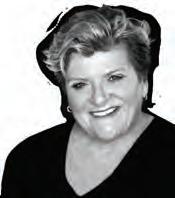










416962-1
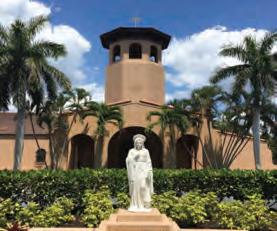
Would
Saturday:
Sunday:









TUESDAY, FEB. 27
A $3K SCRATCH
1 p.m., 3300 block of South Tamiami Trail
Criminal mischief: Citing damage to his uniquely colored Porsche 911 while parked in a bank parking lot, a man estimated the damage to the car to be more than $3,000 because of the manufacturer’s specialty paint. The complainant parked his 2016 sportster in the rear parking lot of the bank at around 8 a.m., at which time he said the vehicle had no scratches. He approached the car during lunch, at which time he saw the damage.
He knows the damage occurred during that time frame, he said, because the

In an enraged reaction to that retort, the complainant said the roommate picked up a hammer and approached him in a threatening manner. Telling him he was going to call the police, the roommate then backed down. The hammer was described as having a black handle, dirty yellow shaft and a black, rusty head. Despite the detailed description, the officer was unable to locate the would-be bludgeoning weapon. Also, G Money was not at the residence at that time.
The complainant requested a police report because when he confronted the driver about the damage, he was told his options were to either take the car and not pay the $1,000 transport fee, or, pay the transport fee and file a claim. The officer witnessed the complainant make a $1,000 payment. Both were provided with the information and were advised it was a civil dispute, and that the complainant should contact his insurance company.
HAMMER TIME
3 p.m. Palmadelia Avenue
Dispute: The complainant reported he was assaulted approximately 45 minutes earlier by a boarding house roommate known only as “G Money.”
He advised that he had just returned home when he thought he heard the landlord at the residence and went to the front door to check. There, Mr. Money was sitting in a chair outside, and the complainant asked if the landlord had been there.
That’s when G. Money allegedly told the complainant to go back to his room, to which he responded that Money should engage in an anatomically impossible act and that “I’m not an 8-year-old. You don’t tell me what to do!”
The complainant contacted the landlord and was provided with G Money’s true identity, which contains neither the letter G nor any reference to legal tender. He completed a written statement, wished to prosecute and was advised that if the subject returned to the residence to call law enforcement.
SATURDAY, FEB. 24 ASSAULT BY SPRAY BOTTLE
2:39 p.m., 1700 block of 17th Street
Domestic disturbance: After an argument between a couple became heated, an officer responded and made contact with a woman who stated she was in a dispute with her live-in boyfriend. She claimed the incident escalated after the boyfriend called her derogatory names and threatened to burn the house down.
The man denied making any such threat, then told the officer that the woman had thrown a spray bottle at him, striking him on the shoulder.
Although the spray bottle did not result in any injury, and the man did not report being battered, the officer wrote in the report, “I believe there was probable cause against (the woman) for domestic battery because the thrown spray bottle struck (the man) against his will.”

The woman was arrested and transported to Sarasota County Jail.










Former Riverview High swimmer Emma Weyant helped the University of Florida women’s swim team to a Southeastern Conference Championship win on Feb. 25 at Auburn University. Weyant won the 500-meter freestyle (4:34.25) and the 400-meter individual medley (4:01.20) and was a part of the Gators’ gold medal-winning 800-meter freestyle relay team (1:40.90). Weyant also finished second in the 1,650-meter freestyle (15:54.62).
… Former Riverview High and Indiana University football player Jamar Johnson, a defensive back, signed with the Saskatchewan Roughriders of the Canadian Football League on March 5. Johnson was selected by the Denver Broncos in the fifth round of the 2021 NFL Draft and spent parts of 2023 with the


Asilver medal represents an accomplishment, but it’s one that the Cardinal Mooney High girls basketball team is tired of.
The Cougars want gold.
Another chance at first place in Florida High School Athletic Association’s Class 3A state tournament will have to wait until 2025. The program’s 2024 season ended March 1 with a 75-51 loss to Miami Country Day School.
The Cougars have now finished as state runners-up four years in a row; three of their losses have been to Miami Country Day.
This year’s Cardinal Mooney team (22-7) thought 2024 was the year things would change, as declared by junior Kali Barrett following the team’s 64-40 regional championship victory over Tampa Catholic on Feb. 22. A 66-52 win over Seffner Christian (25-5) in the state semifinals did nothing to dampen the notion. But beating Miami Country Day (22-8), a program that has now won nine state titles in the last 11 years, is a different type of challenge.
Cardinal Mooney head coach Marlon Williams said the difference in the game was rebounding. Williams said two early rebounds and scores by Miami Country Day senior Kayla Nelms were a warning sign that the Cougars did not have the energy required to win. The 6-foot-1 Nelms, who is ranked as the No. 50 player in the country by ESPN and has signed to play for Baylor University, finished with 24 points and nine rebounds.
In an attempt to guard Nelms and the Spartans’ other offensive threats, Barrett found herself in foul trouble. She played just 19:02 and eventually fouled out early in the fourth quarter. Barrett finished with 12 points, a team high. Freshman forward Madi Mignery, junior guard Sy’monique Simon and senior forward Sam Kotasek all had 11 points, and Mignery added 14 rebounds for a doubledouble.
After the game, Williams said, the team knew it did not play to its potential.
“They were disappointed,” Williams said of his players. “You could see it in their faces. They knew it could have gone better. We just did not have that particular fire that we needed. But we’re going to reset and try to accomplish the goal we have set out to accomplish.”
The season ended with a lopsided loss, but Williams said he was proud of the progress his program made from the season’s beginning to its end, particularly in terms of the team’s movement on offense, both with and without the ball. Knowing when to make an extra pass — and when not to — can be the difference between scoring and being stifled, Williams said. By the season’s end, his team was putting that knowledge to use.
Defensively, Williams said he liked how the team continued to improve its man-to-man defense, though things like rebounding can always be better than they are, as exemplified in the state title game.
Mooney will have as good a chance to get back to the state tournament for a fifth time in 2024 as anyone.
The Cougars are set to return their entire roster save for Kotasek, who will graduate this spring. Barrett led



“They were disappointed. You could see it in their faces. They knew it could have gone better. We just did not have that particular fire that we needed. But we’re going to reset and try to accomplish the goal we have set out to accomplish.”
— Marlon Williams, Cardinal Mooney girls basketball coach
the team with 14.8 points per game and should be just as big a scoring threat as a senior, but all of the Cougars contribute in some way, which is what makes them a difficult out in the postseason. Five Cougars averaged six or more points per game, and three averaged six or more rebounds per game. More growth in those areas will only make the team more dangerous, and perhaps lead them to a fifth-straight state title appearance.
Williams, who just finished year two as the program’s bench boss, said the opportunity to stick with the same group of players for so long is a coach’s dream.
“Going into the third year (next year), the girls know what I want and how I like to do things,” Williams said. “They know we want to be aggressive on the defensive end. I think things like that will only sink in more.”
Beyond the on-court results, Williams said he was happy to see more fans out at the team’s late-season games than have attended in the past. The girls deserve the community support, he said, as does girls basketball in general.
“It’s good basketball to watch,” Williams said. “The girls play hard. So if you want to see good basketball, come out and watch.”
This is Sarasota baseball fans’ chance to see a World Series contender in action.
Jackson Holliday is smooth.
From his swing and stance, to his throwing motion, to the way he signs dozens of autographs for screaming young fans at Ed Smith Stadium, everything that the No. 1 prospect in baseball does feels natural, like he is destined to do this the same way for the next 20 years.
Holliday, 20, was putting his baseball and social skills on display before and during the Baltimore Orioles’ Feb. 29 home spring training game against the Pittsburgh Pirates — a 9-8 Orioles comeback win. After signing autographs, Holliday went 2-for-4 with a triple and an RBI and generally looked the part of a major leaguer despite not being able to order a beer at any of Sarasota’s downtown bars.
Yet Holliday is not guaranteed a spot on the Orioles’ opening day roster. After years of struggles led to a bevy of high draft picks, the team’s roster, particularly its offensive lineup, is loaded. Baltimore showed its potential last season, as I predicted it would, winning 101 games and taking the AL East crown. Then, thanks to some poorly timed pitching injuries and running into a buzzsaw of a Texas Rangers team, Baltimore was eliminated in the first round of the postseason.
The Orioles’ young guns got a taste of the playoffs in 2023. This year, the team will be out for the whole meal. If you’re reading this, you have a chance to catch a seat on the bandwagon. I suggest you do. I know many Sarasota residents
support the Tampa Bay Rays — or, in increasing numbers, whichever team they supported before moving here — but the O’s have called Sarasota their spring home for 15 years now. It’s OK to give them some love, too.
Some of the reasons for that have nothing to do with baseball. The Orioles make it a point to support and give shout-outs to the Sarasota community.
On Feb. 29, Sarasota County Fire Department Deputy Chief Michael Hartley enthusiastically threw out the ceremonial first pitch as part of


the game’s Heroes Day promotion.
On March 10, a Kids Day promotion will allow the area’s youth to run the Ed Smith Stadium bases after the game. On March 12, it will be the area’s seniors’ turn — strolling, not running, around the bases. But the thought remains the same. And on a more macro level, Sarasota County’s most recent annual economic report, covering July 1, 2022, through June 30, 2023, found that the organization generated more than $72 million in economic impact and created more than 970 jobs in Sarasota County in that time span.
But there are baseball reasons, too, namely this one: Baltimore has a chance to win the 2024 World Series.
The Orioles added the ace pitcher they have missed for so long in February, trading two prospects to the Milwaukee Brewers for 2021 NL Cy Young award winner Corbin Burnes, who holds a career 3.26 ERA and is one of the most consistent arms in the sport. Burnes pitched on Feb. 29, and while he was clearly still shaking off the offseason rust — he allowed three runs in 1.2 innings, including a moonshot home run by Pirates’ top prospect Henry Davis — he also struck out three Pirates hitters, showcasing devastating movement on his

pitches. Burnes, a right-hander, will combine with 24-year-old righty Grayson Rodriguez (4.35 ERA in 2023, but 2.58 in the second half) and veteran lefty John Means (2.66 ERA) to make a terrific starting pitching trio. Add righty Kyle Bradish (2.83 ERA) to that group once he returns from a UCL sprain, and things get even more interesting.
Then there’s the team’s position players, which include too many interesting names to list them all.
But here’s a few: Catcher Adley Rutschman, who is entering his second full season with the club and is arguably the best defensive catcher in the game alongside hitting .277. Third baseman/shortstop Gunnar Henderson, who won the 2023 AL Rookie of the Year award after hitting .255 with 28 home runs and 82 RBIs. Outfielder Anthony Santander, who hit .257 with 28 home runs and 95 RBIs. Outfielder Austin Hays, who seems to fly under the radar, even with O’s fans, despite making the 2023 All-Star game and hitting .275 with 16 home runs while playing above-average defense.
Then there is Jackson Holliday. At one point in time, both Rutschman and Henderson were MLB’s top prospect as well, but Holliday may be the most heralded of the three. The son of seven-time All Star
outfielder Matt Holliday, Jackson Holliday flew through the Baltimore farm system in a single season, going from the A-level Delmarva Shorebirds and the AAA-level Norfolk Tides.
He didn’t show any signs of struggling until hitting the Tides, where he faced pitchers with MLB experience, and even then, Holliday hit .267 with an OBP of .796 in 18 games. Getting to see him before he makes his MLB regular-season debut is a once-in-a-lifetime experience fans shouldn’t miss. Is the actual baseball not enough to sway you? The atmosphere at Ed Smith is as lively as ever. The food at the Boog’s BBQ stand is as delicious as ever. And the beer — well, I didn’t have one on the job, but it looked as cold as ever.
There are few better ways to spend a spring day or night than watching great baseball in a great place with great fans. Don’t pass this spring training season up.

Ryan Kohn is the sports editor for the Sarasota/Siesta Key Observer. Contact him at RKohn@ YourObserver.com.


Allison Cole is a junior on the Riverview High softball team. As of March 5, Cole is 4-0 and holds a 1.65 ERA as a pitcher. She also is hitting .625 with five RBIs as a hitter. The Rams are 5-1 as a team after winning four total games in 2023.
If you would like to make a recommendation for the Sarasota Observer’s Athlete of the Week feature, send it to Ryan Kohn at RKohn@ YourObserver.com.
we’re not getting down on ourselves. Coming into the year, I think we did not know what to expect. After the Venice game (an eight-inning, 3-2 Rams win on Feb. 20) we gained some confidence.
What is your favorite food?
Probably any type of pasta. Also, I get Chick-fil-A before almost every game. (Laughs.)


Why did you start playing softball?
My older sister (Megan Fullerton) played softball. She’s seven years older than me. I just wanted to follow in her footsteps at first, but I got used to the game pretty quick. It was easy for me to get into it.
What is the appeal to you?
What is your favorite softball memory? I don’t know if I have one standout memory. My favorite times are usually hanging out with my team before games. It’s like we are all best friends.
What is your best pitch?
It is probably my rise ball. I strike a lot of people out with that, so I tend to throw it when I’m ahead in the count. I also throw a fastball, a changeup, a curveball and a screwball.
What
What has been the key to the
early season success? We’re hitting well right now and
What is your favorite TV show?
Right now I am watching “The Vampire Diaries” a lot.
What are your hobbies?
Recently I’ve gone to the beach and gone shopping (with friends), so usually stuff like that.
Which superpower would you pick?
Teleportation, just so I can get places quickly.
What is the best advice you have received?
Do not be negative with yourself. It is important to always find the positive.
Finish this sentence: “Allison Cole is … ”







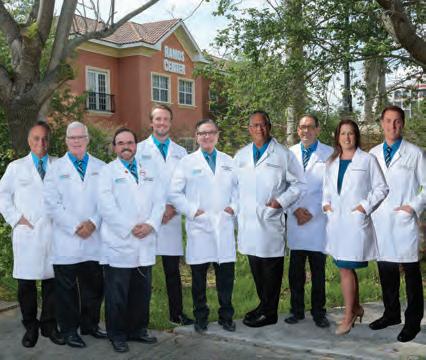












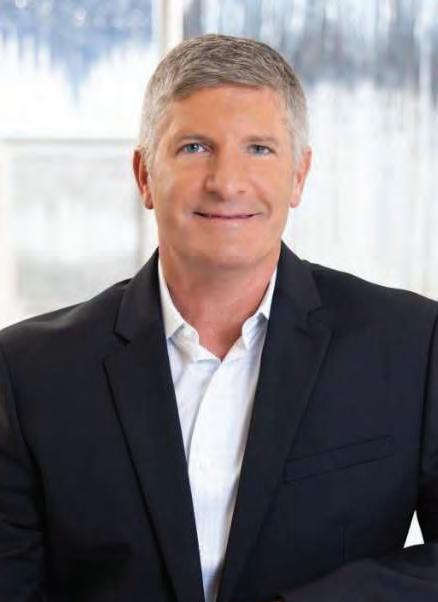






The nonprofit offers young offenders second chances, with fellow teens serving as the attorneys, jury, bailiff and clerk.
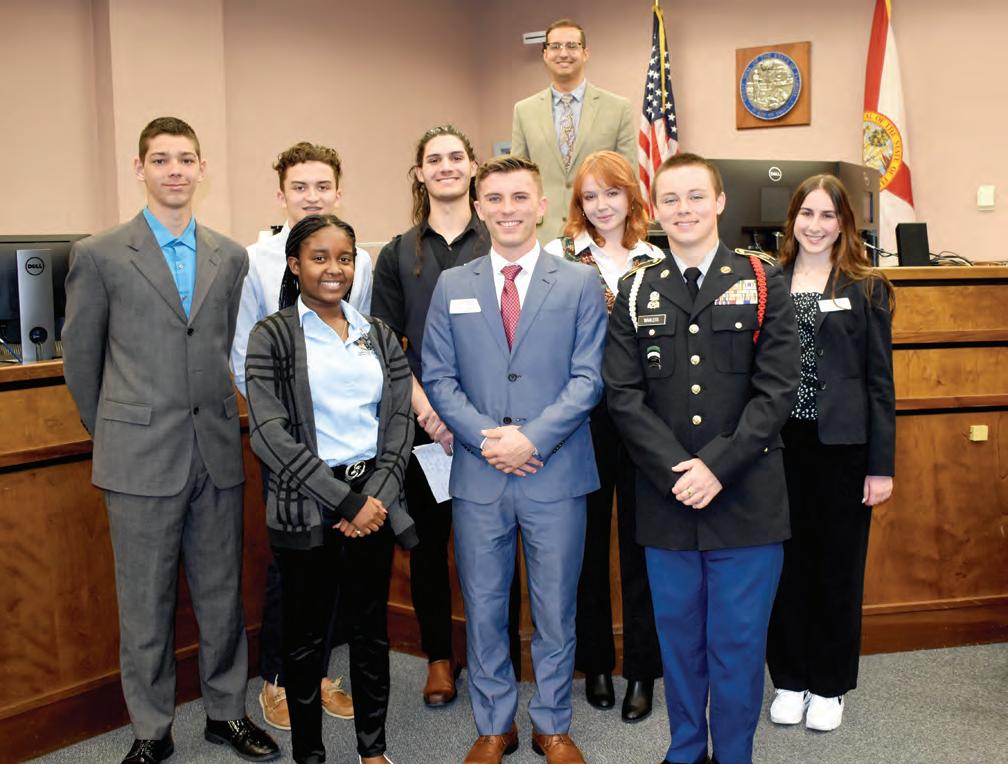
Tabout the nature of law.
Shailee August is a teen attorney who is an 11th grader at Riverview High School and plans to go into either forensic psychology or neuroscience. She found herself impressed with the authenticity of the experience.
those ages 8 to 18 with a misdemeanor or low-level, nonviolent felony charge can undergo a trial through Teen Court, a Sarasota nonprofit focused on offering a second chance to young people.
It may seem like a novel concept that a courtroom staffed entirely by teens can legally serve a role in the community, and yet it’s a model that has been increasingly used in many jurisdictions in the U.S.
The nonprofit has existed in Sarasota County since 1988, when it was established with the support of the senior deputy court administrator, 12th Judicial Circuit Court, law enforcement agencies, the State Attorney’s office and the county.
“It was unheard of, to give young people this responsibility and this opportunity,” said Teen Court Executive Director Heather Todd.
The program became the first in Sarasota, and today is one of two such programs to operate as a nonprofit, rather than as a government entity.
A SECOND CHANCE
The program offers a real legal process that assigns binding consequences, but it also teaches something to its teen attorneys as well
“You automatically assume that it’s going to be this fake court, sort of like mock trial, and then you come in and you realize that it’s not just a mock trial, and you actually get to talk to all of our clients, and to the other attorneys, and it’s a completely life-changing experience, honestly,” she said.
Sometimes, it’s about the people the court serves.
“These are good kids who made one or two bad decisions, and that’s it,” said teen attorney Hayden Wilding, a senior at Sarasota High School who plans to serve in the military and then in public office. “And so, what Teen Court has done is really changed the way I think about people as a whole, especially those who have gone through the legal system, to be a lot more forgiving and empathetic.”
The process of Teen Court mirrors that of a regular court in most ways.
The defendants must swear an oath, while attendees are asked to rise as the jury enters and exits.
However, instead of an innocent or guilty verdict, respondents are given a verdict deemed to be a suitable consequence — up to 50 community service hours, up to six jury duty sessions as well as peer circle sessions, drug testing, letters of apology, essays or reports.

When young people complete the program successfully, their case will be dismissed, with no record of the charge.
The success rate of the program is 94% and it saves taxpayers over $3.5 million a year by keeping young people out of the system, according to Katy McBrayer-Lynch, the president of Teen Court.
There are few who could better attest to its effectiveness than she can.
When she came to the organization as a teenager 22 years ago, she had been kicked out of her home and was sleeping in abandoned houses and, having stolen her mother’s gun, was charged with burglary, grand theft and possession.
Then she found Teen Court and Todd, who was her client coordinator.
“Even at the time, she was like, this girl is a lost cause,” McBrayerLynch said. “But the programs she chose and the way that affected my life, it saved my life. And now, I’m super successful. I have a family. I’m married to a cop. And I’m president of Teen Court. It goes full circle. That day really changed my entire trajectory.”
The nonprofit also offers other services including Camp X-RAYD, which works to rehabilitate teens who are using illegal substances, substance abuse education class, mental health counseling, life skills, law-related education, individual and family counseling, drug testing and education on healthy digital practices.
When: 5:30 p.m. to 8:30 p.m.
March 6 Where: Michael’s on East, 1212 S. East Ave.
Sponsorships: $475-$5,000
Tickets: $200-$475
Youth tickets: $100 each
For information: Visit SarasotaTeenCourt.org.
As a teen attorney, August can also attest to the impact of the organization. In the hallways at school, she’ll find herself saying “hi” to former clients. She’s had people come to her and tell her how Teen Court changed their lives, and how they would never commit an offense again.
She thinks that because of the understanding between people of the same age, the organization can help them in a way that a regular court can’t.
“It’s this take on law that just benefits, and I feel like law in the real world outside of Teen Court doesn’t necessarily always have that impact, but since this is just a sentencing court, you can actually change people’s sentences to improve their lives rather than punish them, and I think it completely changed my view on law,” she said. Wilding echoed her comments.
“That is ultimately, the most

important thing in Teen Court that’s driving such success, the fact that clients and jurors and attorneys, everyone is a peer, and that means that the empathy goes all around, and you can really understand one another and support one another before, after and during Teen Court,” he said.
One would assume that the youth who have gone through Teen Court would be more lenient with the sentencing, August said, but instead, she finds the sentences offer suitable consequences.
One purpose of the program is the education of the young people who serve in the courtroom.
“It’s an academic, competitive, logic-based fun that you’re never going to see anywhere else,” Wilding said.
When Teen Court is held at Sarasota’s Criminal Justice Center, Todd shakes all the teens’ hands to ensure they make good eye contact — and that they will do the same with their clients.
Teen attorneys undergo training every four months, and they shadow and practice in the role until they are ready, after serving on jury duty twice, and as clerk or bailiff.
No one is required to adopt a role, but the organization ensures that everyone learns something from the experience, with jurors being asked to raise their hands to offer an explanation of the verdict.
“We may have a very shy student on that jury; we want them to stand up, and we want their voice to be heard,” Todd said.
There are no specific requirements to serve in the courtroom.
“I don’t care about their GPA,” Todd said. “They’re compassionate, they’re empathetic, they’re kind — those are the qualities that I look for in volunteers.”
Nonetheless, a look at a session of Teen Court finds that teen attorneys exercise a command of the language and the reasoning employed in a courtroom.
Trial lawyer Patrick Iyampillai, who volunteers with the organization as a judge, said he found himself impressed with the process the young people demonstrated, and the thought put into the verdicts with their assessment of the defendant, and whether they took responsibility for their actions.
“I was blown away by those jury verdicts and how thoughtful they were,” he said.
He is also glad for the service the nonprofit provides. Its reach goes beyond the defendants themselves, he said.
“It shows the defendants how to take a step back and how their actions led to consequences that have affected all of us in the community, and for that they will be better community members and people moving forward in life — and that’s all so priceless.”














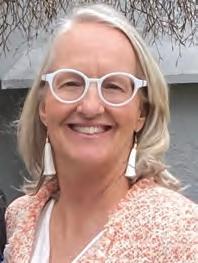



Is ice cold? Is the night black?
Does body odor stink? For author and science writer Ed Yong, the answer is: It depends on whom you ask. Or, more specifically, what kind of animal you ask.
That is the lesson in his book, “An Immense World,” which he spoke about at the annual One Book One Community event held by Sarasota County Libraries on March 1. During his hourlong talk at Selby Library to a crowd of more than 350, Yong discussed research on how animals perceive the world and how it can expand humans’ understanding of it.




Yong gave several examples of how animals experience the environment around them, a term called “umwelt.” For example, manatees have a poor sense of sight, but, with whiskers covering their entire bodies, they have a highly sensitive sense of touch, which allows them to gather information on currents and water patterns that affect their survival.
“Understanding these things changes our understanding about what other animals are doing,” Yong said.
Dogs are another good, and familiar, example. Although humans think about a walk’s purpose as primarily exercise and a way of getting from A to B, a dog’s purpose is completely different.
“We’ve all experienced a dog halting to a stop to intensely focus on a leaf or a patch of pavement,” Yong said. “What looks completely nondescript to the eyes is bursting with information to the nose.”
With long slits in the sides of their



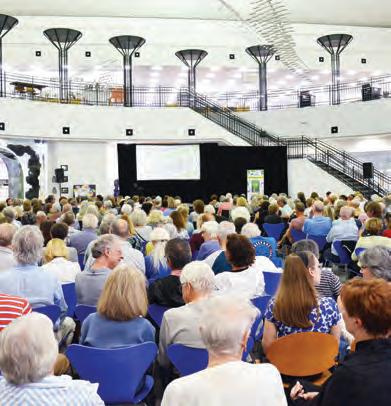
nose
But every sensory strength comes with tradeoffs. Using the earth’s magnetic field, sea turtles can navigate through the ocean back to the beaches where they hatched. But this navigation only works over long distances. “They’d struggle to find your bathroom from your bedroom,” Yong said.
The same is true for humans, who have among the best vision in the animal world. Not only is it “really, really weird” for an animal to have two eyes on the front of its head, but the only animals with higher resolution vision are birds of prey.
The down side? “Our eyes really suck in the dark,” Yong said. Eyes can be high in acuity or sensitivity, never both.
Likewise, humans can’t see ultraviolet light, which means we see the world completely differently than a bee sees a flower or nocturnal animals see the night, which doesn’t look black at all to them.
Understanding how other animals perceive the world not only expands our understanding of it, it also helps us see how we impact it.
Light pollution disrupts nocturnal animals’ ability to see and navigate in the dark. Environmental pollu -
■ Because bees see in ultraviolet, flowers have evolved colors and patterns to attract them.
■ Owls have ears that are slightly offset, allowing them to triangulate prey using their hearing.
■ Manatees’s upper lips are as sensitive as human fingertips, and they use their lips to explore the world around them.
■ Birds’ eyes are on the sides of their head, which means they can see all around them without turning their head. “A bird’s visual world surrounds it,” Yong said.
■ Spiders have multiple eyes, but each set is used for a different purpose. One is used for motion, while the others see objects.
■ The whiskers on a sea lion’s face can detect the path of fish by feeling the turbulence they make in the water.
■ Bats’ use of sonar hearing is so precise that they can gauge distances around them within a millimeter.
■ Dogs evolved from wolves, who adapted to scavenge from humans. Yong described domesticated dogs as “peoplepleasing trash wolves.”
tion plays tricks on animals’ sense of smell and chemical receptors. And noise pollution limits animals’ communication with one another, which makes it harder for everything from whales to songbirds to find mates.
These things aren’t just a pollution of the environment, Yong said, but a “pollution of disconnection” for humans, making us feel less part of the world around us.
There’s benefit for humans and nature if we can look outside our own experiences.





“Thinking about how other animals sense the world brings us to our responsibility in it,” Yong said. “But the only way to really experience what another animal senses is through imagination.”






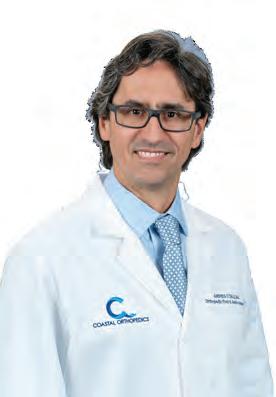
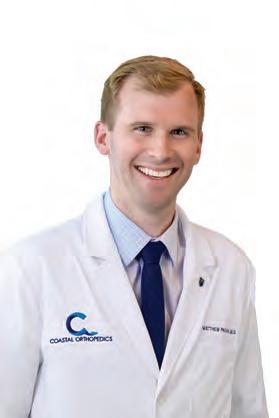





Sarasota County History Day Contest winners and runners-up will represent county in state event.
JAMES PETER MANAGING EDITORScience fair normally gets all the academic exhibition fanfare, but Sarasota County is working to make room for another student-led project showcase: history fair.
The Selby Library Rotunda hosted this year’s Sarasota County History Day Contest entries on Feb. 24. Judges spent the day reviewing exhibits, performances, documentaries, websites and papers from 84 Sarasota County middle school and high school students.
The judges also interviewed each of the students and assessed their ability to represent the county at the Florida History Day Contest May 5-7 in Tallahassee. Students who excel in that competition can then represent their schools in the National History Day Contest in June.
Saturday’s competition was just the beginning of the competitive phase of the history contest, for which students began working on their projects in August 2023.
Each year in August, participating teachers in the county “share the annual theme with students and walk them through the projects and how to break them into chunks,” explained Jennifer Jaso, Sarasota County Schools History Day coordinator. Jaso is an eighth grade civics teacher at Sarasota Middle School.
This year’s contest theme was “Turning Points in History.” Students can choose to work solo or as part of a group in one of five categories: paper, website, exhibit, documentary or live performance. Stu-

dents compete in either the Junior Division (middle school) or Senior Division (high school).
From August until December, students narrowed their topics, researching them, constructing their arguments and then building their projects. In December, the students submitted their projects to their classroom teachers for grading and feedback.
“Not only (must students) explain their thesis, but they have to provide evidence to prove it and explain the historical significance — the ‘So what, why should we care?’” said Jaso.
That same question is sometimes aimed at the discipline of history itself.
“(History Day) is about helping students gain a passion and a commitment for continued learning beyond the classroom,” said Jaso. “History Day is the epitome of that. Students get to engage in a process that encourages them to think critically and draw their own conclusions rather than regurgitate from a textbook. It teaches them that their voice and perspective matters.”
The projects also push students to be creative, help them learn how to talk with adults, and give them real experience in determining which sources are reliable and how to account for sources’ bias, said Jaso.
Olivia Gambert, 14, began to think critically about how Hawaii became
a part of the U.S. after a trip with her family to visit the Hawaiian islands.
“There are still protests there today,” said Gambert.
The Sarasota Middle School student’s exhibit, “Aloha ‘Oe: American Expansionism Results in a Stolen Kingdom,” explores the annexation of Hawaii in 1898 and the struggles that preceded it and that have followed.
“A lot of people think Hawaii agreed to (annexation),” said Gambert, who described how Queen Lili’uokalani of Hawaii was overthrown illegally. In 1993, President Bill Clinton signed a resolution of apology acknowledging the overthrow a century earlier.
Gambert won first place in the Junior Division individual exhibit category.
Fellow Sarasota Middle School student Jonathan Rohrbacher, 14, won first place in the Junior Division historical paper category for his project “The First Use of Chemical Weapons: How the 1915 Battle of Ypres Changed War Forever.”
Rohrbacher said he became interested in the topic after learning about WWI. The use of chemical weapons in that war would have grave consequences for the future, he said.
Rohrbacher and Gambert will represent Sarasota County at the Florida History Day Contest in Tallahassee, along with their fellow first- and second-place category winners.





JUNIOR DIVISION (GRADES SIX
TO EIGHT)
Individual Performance
1. Madison Muller, Sarasota Middle School, “26.2 Miles: How Bobbi Gibb Defied the Stereotypes.”
Group Performance
1. Simone Vaccaro, Henrik Casart & Helena Kushner, Booker Middle School, “The Blight of Ireland: How Potatoes Changed the World.”
2. Julia Sharrock, Grace Toale & Aanvi Patel, Sarasota Middle School, “Disease, Devastation, and Death in Ireland; An Gorta Mor.”
Individual Documentary
1. Laurel Karp, Sarasota Middle School, “Upton Sinclair’s The Jungle: Its Effects on Public Health and Safety.”
2. Jeremiah Barker, Brookside Middle School, “How One Painting Changed the World Forever.”
Group Documentary
1. Sophia Raicu and Sameera Velagapudi, Pine View School, “The Green Revolution: How Norman Borlaug Changed Agriculture Forever.”
2. Julianna Lake and Ada Skadal, Sky Academy Englewood, “How did Women’s Fight for Independence Affect Their Clothing?”
Historical Paper
1. Jonathan Rohrbacher, Sarasota Middle School, “The First Use of Chemical Weapons: How the 1915 Battle of Ypres Changed War Forever.”
2. Cameron Klare, Sarasota Middle School, “Ms. Magazine and the Growth of the Feminist Movement.”
Individual Website
1. Nina Rizzo, Sarasota Middle School “The War of 1812: A Turning Point in Early U.S. History.”
2. Evan Valdivia, Sarasota Middle School, “Connecting People Through Time: The Telephone.”
Group Website
1. Nicholas Brown and Sebastian Delgado-Knaack, Sarasota Middle School, “The Battle of Midway.”
2. Nicole Hoffman and Brooke Eby, Sarasota Middle School, “Pearl Harbor.”
Individual Exhibit
1. Olivia Gambert, Sarasota Middle School, “Aloha ‘Oe: American Expansionism Results in a Stolen Kingdom.”
2. Andrew Fenton, Sarasota Middle School, “Luther’s 95-Theses and The Protestant Reformation.”
Group Exhibit
1. Ella Berzins and Ella Ramos, Sarasota Middle School, “The Fall of the Berlin Wall”,
2. Maya Tow and Adrita Mukherjee, Sarasota Middle School, “The Fall of the Berlin Wall.”
Individual Documentary
1. Christian Cooper, Sarasota Christian School, “The Miracle that Turned the Tide of the Cold War.”
2. Autumn Boehm, Sarasota Christian School, “The Innovation and Integration of the Solid-Body Electric Guitar.”
Group Documentary
1. Peyton Gray and Wyatt Campbell, Sarasota Christian School, “Speech is Power: The Media’s Impact on Public Opinion.”
Historical Paper
1. Noah Spenn, Sarasota Christian School, “The Morning America Saw More Than One Sun Rise: How the Bombing of Pearl Harbor was a Turning Point in History.”
2. Stephen Godwin, Sarasota Christian School, “The Creation of Insulin.”
Individual Website
1. Evie Irwin, Sarasota Christian School, “The Nixon Shock: How Freezing the Economy Changed the United States.”
2. Hayden Rogers, Sarasota Christian School, “The Selma Marches: A Turning Point in the Civil Rights Movement.”
Individual Exhibit
1. Grace Chren, The Out-of-Door Academy, “Byzantine Church Architecture and Its Impact on Modern Architecture and Christian Society.”
2. Genesis Nopal-Puente, Booker High School, “The Pastry War.”






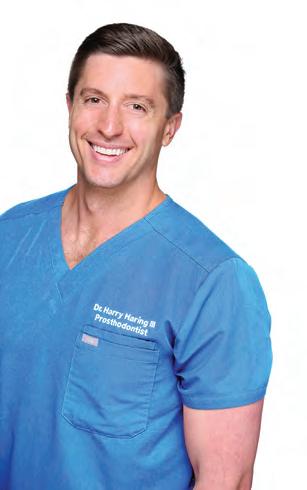
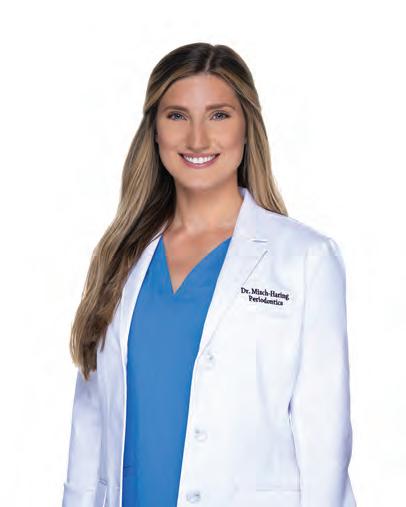



Over the span of 65 years, the Jewish Federation of Sarasota-Manatee has grown from a small group of individuals working to foster and connect the area’s Jewish community to a robust organization dedicated to the same mission. That fact was evidenced by the Jewish Federation’s celebration Feb. 25, held at its new event space, The Ora.
The event marked the importance of marrying the past, present and future with its programming, which included performances by Israeli American dance ensemble Keshet Chaim and a show of solidarity with a section of empty chairs bearing photos of missing Israelis from the abductions in Israel last year.
During the evening, the organization thanked Bruce Udell for his service as board president, while also welcoming Deb Kabinoff, who will become president of the board starting April 1.
The Jewish Federation of SarasotaManatee holds programming and events throughout the year to connect and engage the Jewish community. This includes education grants, mission trips to Israel and efforts to fight antisemitism.
— OBSERVER STAFF

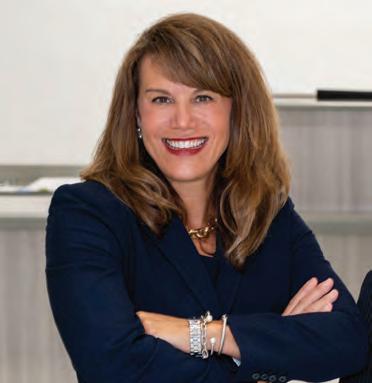




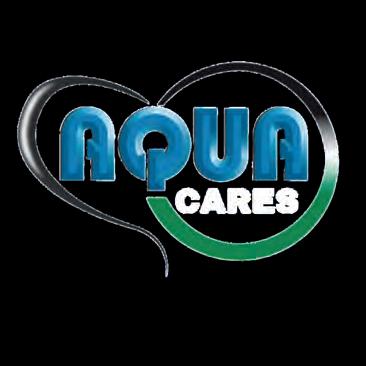









The Ritz-Carlton, Sarasota, has space for over 600 guests attending a formal luncheon to celebrate a crystal anniversary, and Empath Tidewell Foundation’s Signature Luncheon was a sellout on March 1. Symbolizing light, clarity and the durability of love, the crystal is only some of what Tidewell Hospice provides to patients who are at the end of one journey and moving onto another. The Tidewell Foundation is able to deliver care through the help of many sponsors, donors, volunteers and patrons.
With the vision of Co-chairs Julie Delaney and Kathy Martella and their committee, the elegant event was emceed by Summer Smith. Tidewell Foundation President Delesa Morris and Empath Health President and CEO Jonathan Fleece gave remarks Empath’s certified music therapist, Haley Verinder, sang a cover of Maroon 5’s hit song, “Memories.” Kelly Caldwell, president and CEO of Caldwell Trust Co., told his story about his interaction with Tidewell hospice when his dad became ill, and Joann Day-Dormeyer, the mom of Chad Day, was introduced on stage after a video about
her experiences when her son was diagnosed with a brain tumor. There was a collective murmur in the room when it was announced that Chad’s kitten, Hazel, was welcomed into hospice with him, and that Tidewell provides pet therapy to patients.
The keynote speaker, Marilu Henner, took her place at the podium to deliver a personal history about her various journeys with family members who have gone through hospice.
The actress, health advocate, bestselling author and mom of two delighted guests with her wisdom and insight about her father’s death, memory and advocacy.
One of only roughly 62 documented cases in the world, Henner has hyperthymesia, which allows her to spontaneously recall personal experiences and their associated dates. Since 2019, Henner has been the spokesperson for the National Hospice and Palliative Care Organization, where she raises awareness about hospice care and the benefits it provides to patients as well as the family.
— JANET COMBS














Discover Wild Blue at Waterside during the Parade of Homes, and tour seven newly unveiled designer-decorated models. Featuring a prime Lakewood Ranch location, this waterfront community features single-family homes by the area’s finest builders, plus incredible amenities that include a 13-acre sports complex, fabulous social clubhouse with indoor and outdoor dining, two pools, movie theater, fitness center and 9-hole premier putting course.
US
MARCH 9TH–28TH
MON–SAT 10AM TO 5PM
SUN 12PM TO 5PM

Residences from








At its annual Collaboration Celebration
Feb. 29, the Glasser/Schoenbaum
Human Services Center honored three individuals it believes are poised to make an impact on Sarasota’s human services community in the future.
Andre McClerklin Jr., with the Florida Department of Health in Sarasota County; Dawnyelle Singleton, manager of volunteers and community programs at Planned Parenthood of Southwest and Central Florida; and Sara Brunow, education and engagement director at Asolo Repertory Theatre, were presented with Emerging Leader awards in front of the crowd of about 150 at the Carlisle Inn.
Each of the recipients received $1,000 to use to improve their leadership skills to benefit their organization or the community. In addition to the monetary award, recipients will meet three times during the year with mentors to discuss how they used the funds, what challenges they face in their work and how they can become better leaders.
The event benefited Glasser/Schoenbaum, which seeks to create and support a network of human services-focused nonprofits in the Sarasota area.
— OBSERVER STAFF




















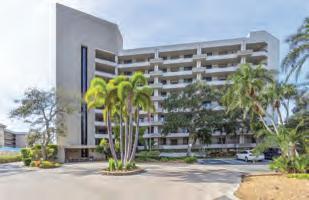



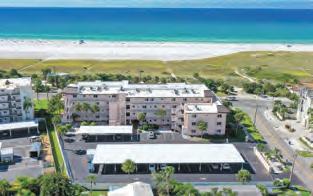


















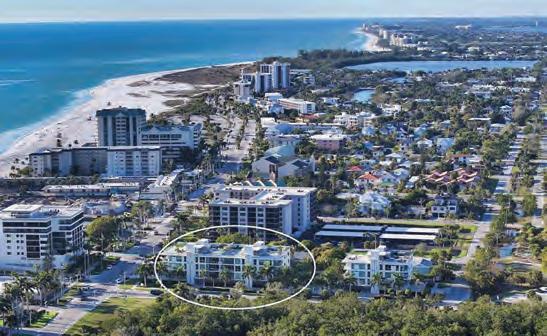
Ahome in Oyster Bay Estates tops all transactions in this week’s real estate. Linda Balot, trustee, of Sarasota, sold the home at 1124 N. Lake Shore Drive to Fred Starling and Tina Starling, trustees, of Sarasota, for $10,625,000. Built in 1990, it has five bedrooms, fiveand-a-half baths, a pool and 7,169 square feet of living area. It sold for $4.7 million in 2017.

HUDSON PARK
Ronald Marano, of Sarasota, sold the home at 2495 Browning St. to Christopher Claypoole and Nedra Foster and Rochelle Claypoole, of Sarasota, for $975,000. Built in 1963, it has four bedrooms, three baths and 2,008 square feet of living area. It sold for $475,000 in 2022.
BELLEVUE TERRACE
BEAU
Charles and Patti Efflandt, of Flat Rock, North Carolina, sold their home at 3331 Old Oak Drive to Erik Kooba, of Bloomington, Illinois, for $1.85 million. Built in 1950, it has three bedrooms, three-and-a-half baths, a pool and 2,483 square feet of living area. It sold for $1.05 million in 2015.
PINE SHORES ESTATES
Alise Angel sold the home at 6434 Hollywood Blvd. to Morad Awadallah and Melissa Jaber, of Sarasota, for $1,525,000. Built in 1962, it has three bedrooms, three baths, a pool and 1,936 square feet of living area.
RHODES & HALE
Daniel Bridinger, of Tampa, sold two properties at 320 Ohio Place to 320 Ohio Place LLC for $1.04 million. The first property was built in 1925, it has three bedrooms, two baths and 1,698 square feet of living area. The second property was built in 1925, it has one bedroom, one bath and 360 square feet of living area. They sold for $350,000 in 2012.
GRANADA
Martha Mook and William Siegel, trustees, of Fort Pierce, sold their home at 1656 Catalonia Lane to Granada Park Home LLC for $990,000. Built in 1947, it has two bedrooms, two baths and 1,730 square feet of living area.
Stuart and Jeannine Daneman sold their home at 3060 Courtland St. to Richard and Carrie Stem, of Myakka City, for $775,000. Built in 1957, it has three bedrooms, two baths and 2,327 square feet of living area. It sold for $73,700 in 1992.
PHILLIPPI LANDINGS
Matthew Unger and Megan Marie Unger, of Sarasota, sold their Unit 1102 condominium at 1904 Monte Carlo Drive to Cody and Ciera Stokes, of Canfield, Ohio, for $680,000. Built in 2021, it has three bedrooms, three baths and 1,745 square feet of living area. It sold for $452,500 in 2021.
BAY HAVEN
Deborah Downing, of Sarasota, sold her home at 825 Tennessee Lane to Sean Drake and Isida Drake, of Clearwater, for $612,500. Built in 1955, it has three bedrooms, two baths and 1,526 square feet of living area. It sold for $83,500 in 1993.
GROVE LAWN
Margaret Klein, of Bradenton, sold her home at 2156 Wisteria St. to M. Franqui Investment LLC for $575,000. Built in 1974, it has three bedrooms, two baths, a pool and 1,704 square feet of living area. It sold for $88,000 in 1990.
PAVER PARK ESTATES
Valerie Lynn Williams, trustee, of Sarasota, sold the home at 2500 S. Paulstan Court to John Barron and Lauren Wood, of Sarasota, for $550,000. Built in 1952, it has three bedrooms, two baths and 1,684 square feet of living area. It sold for $160,000 in 2010.
DESOTO TERRACE
Greybeard Properties LLC sold the home at 848 Myrtle St. to Diane Stull, trustee, of Sarasota, for $535,000. Built in 1956, it has two bedrooms, two baths and 1,410 square feet of living area. It sold for $492,000 in 2023.
GULF GATE EAST
Christopher Esposito, trustee, of Flushing, New York, sold the home at 3817 Easton St. to Brian Frank Novak, of Sarasota, for $515,000. Built in 1983, it has three bedrooms, two baths, a pool and 1,480 square feet of living area. It sold for $130,000 in 1993.
Matthew and Jamie Voss, of Cape Coral, sold two properties at 1361 16th St. to Colette Shock, trustee, of Sarasota, for $508,000. The first was built in 1940, it has three bedrooms, one bath and 1,024 square feet of living area. The second was built in 1940, it has one bedroom, one bath and 380 square feet. They sold for $155,000 in 2020.
Siesta Beach
Theresa Suits, of Zionsville, Indiana, sold the home at 825 Tropical Circle to Sheryl Riley, trustee, of Sarasota, for $6,995,000. Built in 2010, it has four bedrooms, four-and-two-half baths, a pool and 5,904 square feet of living area. It sold for $3,925,000 in 2017.
La Vista
Donna Wilson, trustee, of Sarasota, sold the home at 7791 Calle Facil to Brian and Stephanie Hanuschak, of Sarasota, for $1,075,000. Built in 1988, it has four bedrooms, three baths, a pool and 3,292 square feet of living area. It sold for $500,000 in 2013.
South Creek
Alison Thurau, trustee, of Osprey, sold the home at 1851 Island Way to Anna Katherine Frazier Boettcher and Zachary James Boettcher, of Osprey, for $3.95 million. Built in 1981, it has four bedrooms, five baths, a pool and 5,233 square feet of living area. It sold for $575,000 in 1999.
Blackburn Ridge Raymond Grandchamp Jr., trustee, of Bradenton, sold the home at 4913 Topsail Drive to Dominic and Jannee Pugliani, of Granbury, Texas, for $4.1 million. Built in 2015, it has five bedrooms, five baths and is 4,399 square feet.





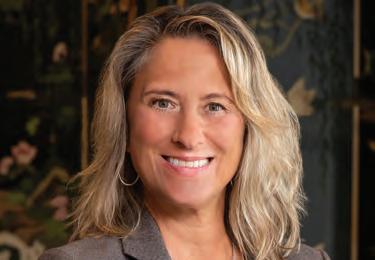














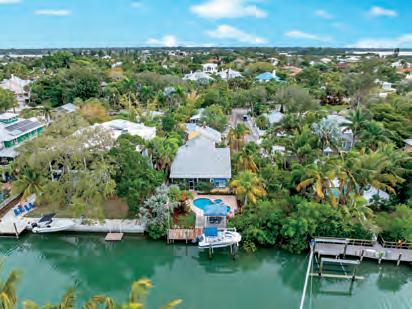


and humor. Visit Ringling.org/event/ ringling-underground/
FRIDAY, MARCH 8 COUNT THE LEPRECHAUN DOORS
11 a.m. at the Sarasota Children’s Garden, 1670 10th Way. Included with the cost of admission (free for members) while supplies last. Hunt for leprechauns by finding the green sparkly doors scattered around the garden, then color your own leprechaun door. Visit SarasotaChildrensGarden.com.
K.O.P.S. NIGHT
4 to 6 p.m. (8- to 11-year-olds) 6 to 8 p.m. (12- to 15-year-olds) at Robert L. Taylor Community Complex, 1845 34th St. Free. Kids and Officers Promoting Solidarity (K.O.P.S.) is a program created in partnership with the Sarasota Police Department to promote positive relationships between youth and police officers. Kids and cops will take part in fun activities together like basketball, volleyball, soccer, billiards and video games — all with safe supervision. Free dinner and refreshments provided. To register visit Kops-march-8-11. eventbrite.com, stop by Robert L. Taylor Community Complex or call RTLCC at 941-263-6562.
SATURDAY, MARCH 9 25TH ANNUAL ST. PADDY’S DAY POKER RUN
11:30 a.m. to noon at The Humane Society of Sarasota County, 2331 15th St. $10 per hand or three hands for $20. This rain-or-shine event invites all motorcycle riders to support the Humane Society by buying poker hands for the chance to win a cash prize for best and worst hand. There will be three stops on this year’s run, Duffy’s Sports Grill,



BEST BET
SATURDAY, MARCH 9
LEMARCHE BOHEMIEN OUTDOOR MARKETPLACE
10 a.m. to 5 p.m. at Five Points Park, 1 Central Ave. Free. This Parisianinspired, open-air marketplace brings together a variety of artisans making unique goods and art, including paintings, sculptures, jewelry, ceramics, photography and woven wearable art. Visit DestinationDowntownSarasota. com/lemarche-parisian-outdoor-marketplace

The Paddy Wagon and Mulligans. The final stop and party will be held at Clancy’s Irish Sports Pub, Bar & Grill, in its Freaky Tiki, at 6218 Cortez Road, Bradenton. Call 941-720-5955 or visit HSSC.org/get-involved/ events.
SUNDAY, MARCH 10
SUNDAYS AT THE BAY
6 p.m. at The Bay Park, 1055 Boulevard of the Arts. Free. This week’s concert features Speak Easy, a four-piece band with electric guitar solos and an upbeat vibe. Great for fans of all ages. Bring your own chair to ensure a comfortable seat. Visit TheBaySarasota.org.
MONDAY, MARCH 11 ROOTS OF BLACK MUSIC IN AMERICA - PART 2
6 p.m. to 7 p.m. at Selby Library 1331 First St. Free. Enjoy learning about the songs and stories of Black musical artists like Marvin Gaye and Stevie Wonder. Presenter Karlus Trapp will dive into the history of blues, jazz, pop and rock and take the audience on a musical journey. Visit SCgovlibrary.librarymarket.com



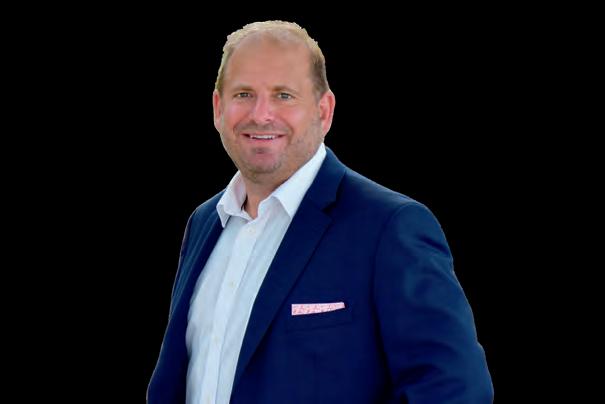














By Luis Campos
“UWIA WBH’S DAXIAOS. TEAH PZK JAS Y
VHZOV, PZK EYFA SZ JAS KD, LKBS
“F’I CMVP YSIGSVBTWZM EFBR IPUMZG TXK IP UMONTZFBP, WNB FB KSMUX’B
KMGFXM IM. F TZUS VMTK WSSJU, WMZFMCM FB SV XSB.” MCT IMXKMU “H





























